Vol. 69, No. 4 (2020)
2020-02-20
INVITED REVIEW
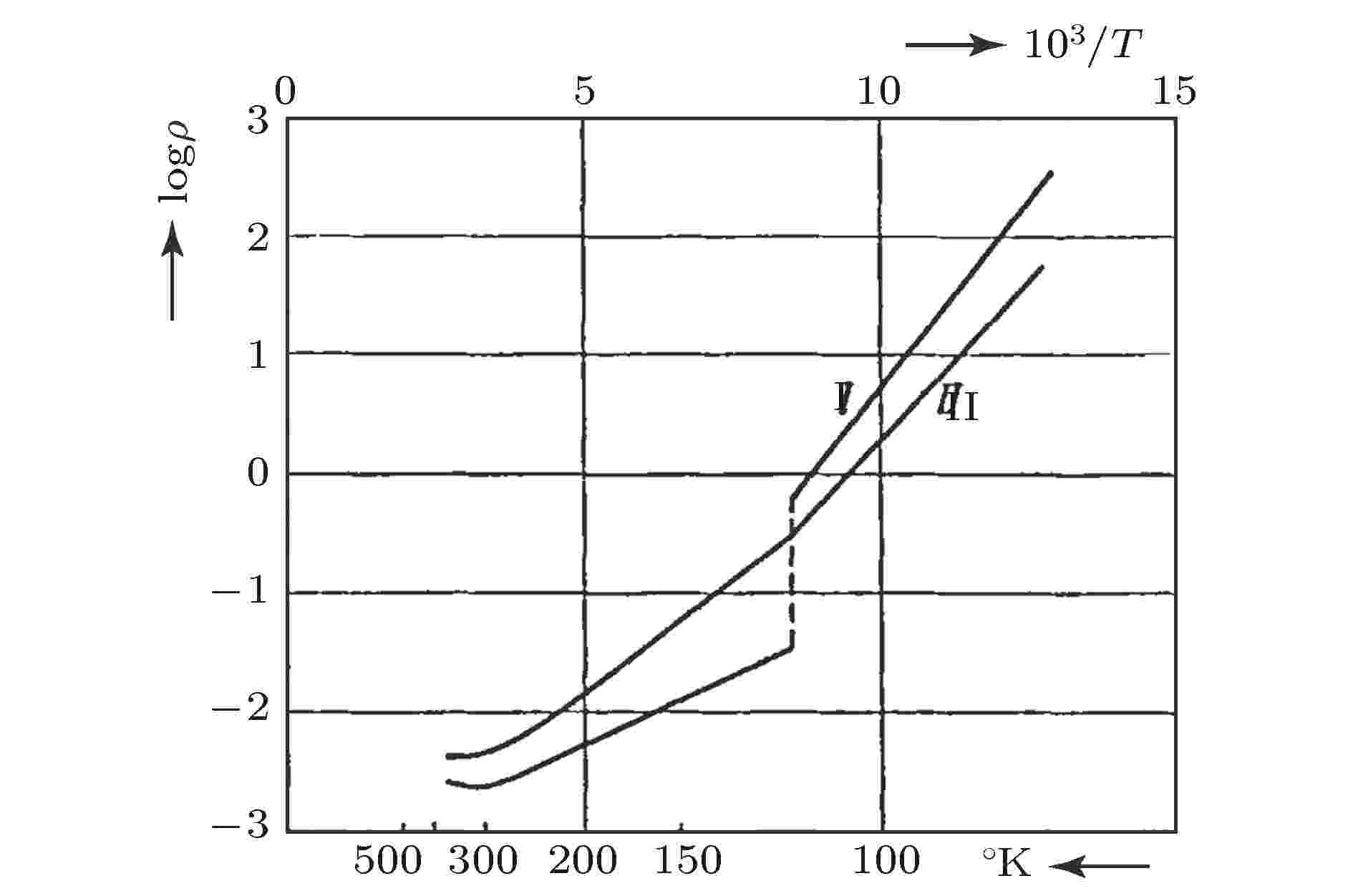
EDITOR'S SUGGESTION
2020, 69 (4): 040505.
doi:10.7498/aps.69.20191763
Abstract +
As the first known metal-insulator transition, Verwey transition of Fe3O4attracts much attention due to its fascinating physics. With the decreasing temperature across Verwey temperature, Fe3O4undergoes the transition of lattice distortion, charge ordering, electricity, magnetic anisotropy, etc, but the magnetic ground state keeps the ferrimagnetism. The comprehension of the underlying physics in Verwey transition facilitates the understanding of metal–insulator transition in other strongly-correlated systems. Nevertheless, the mechanism of Verwey transition is still debated after the first glimpse of Verwey transition. In this paper, we summarize the research history and current status of Verwey transition in Fe3O4. The investigations of lattice structure, charge ordering, electronic transport, magnetic and ferroelectric properties of Fe3O4across Verwey transition are reviewed. Finally, the summary and outlook are given.
REVIEW
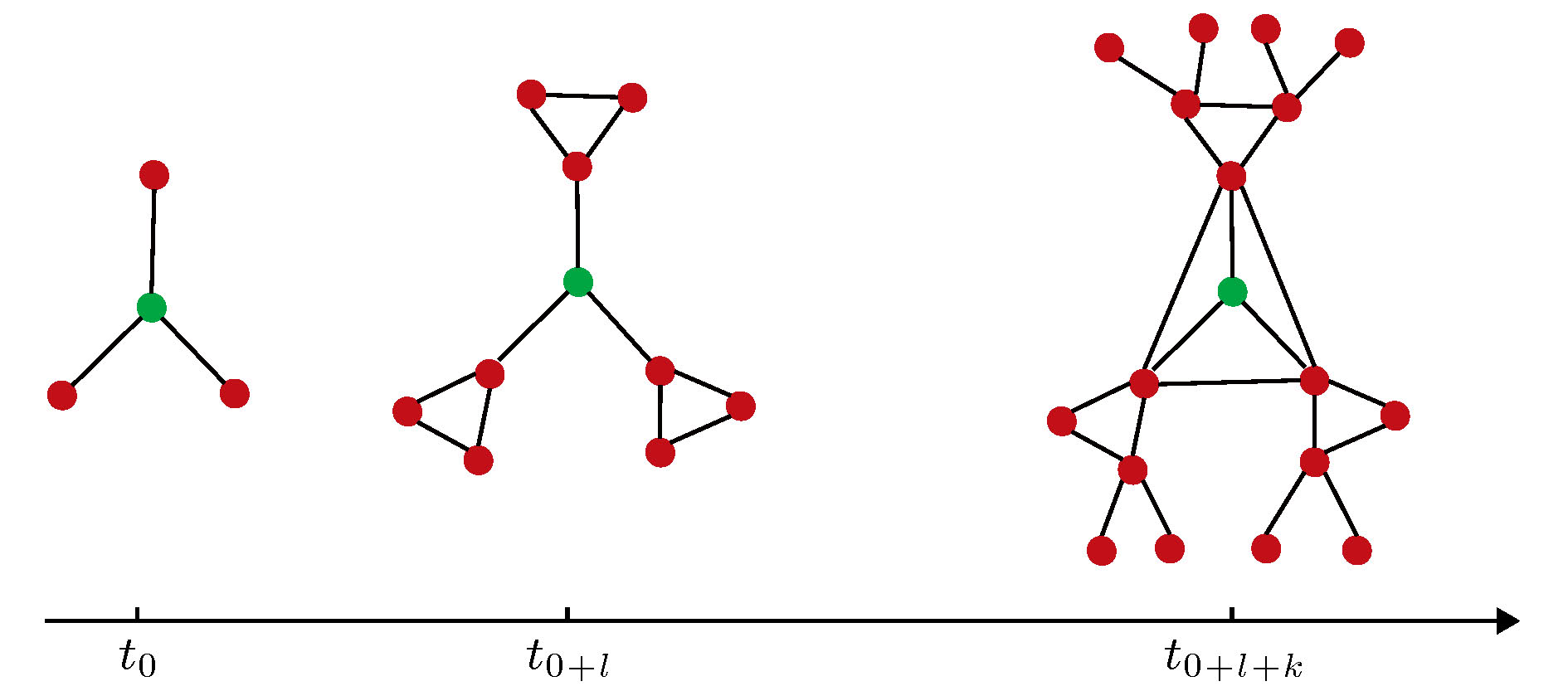
2020, 69 (4): 048901.
doi:10.7498/aps.69.20190830
Abstract +
Crucial to the physicists’ strong interest in the field is the fact that such macroscopic properties typically arise as the result of a myriad of interactions between the system constituents. Network science aims at simplifying the study of a given complex system by representing it as a network, a collection of nodes and edges interconnecting them. Nowadays, it is widely recognized that some of the structural traits of networks are in fact ubiquitous properties in real systems. The identification and prediction of node influence are of great theoretical and practical significance to be known as a hot research field of complex networks. Most of current research advance is focused on static network or a snapshot of dynamic networks at a certain moment. However, in practical application scenarios, mostly complex networks extracted from society, biology, information, technology are evolving dynamically. Therefore, it is more meaningful to evaluate the node's influence in the dynamic network and predict the future influence of the node, especially before the change of the network structure. In this summary, we contribute on reviewing the improvement of node influence in dynamical networks, which involves three tasks: algorithmic complexity and time bias in growing networks; algorithmic applicability in time varying networks; algorithmic robustness in a dynamical network with small or sharp perturbation. Furthermore, we overview the framework of economic complexity based on dynamical network structure. Lastly, we point out the forefront as well as critical challenges of the field.
GENERAL
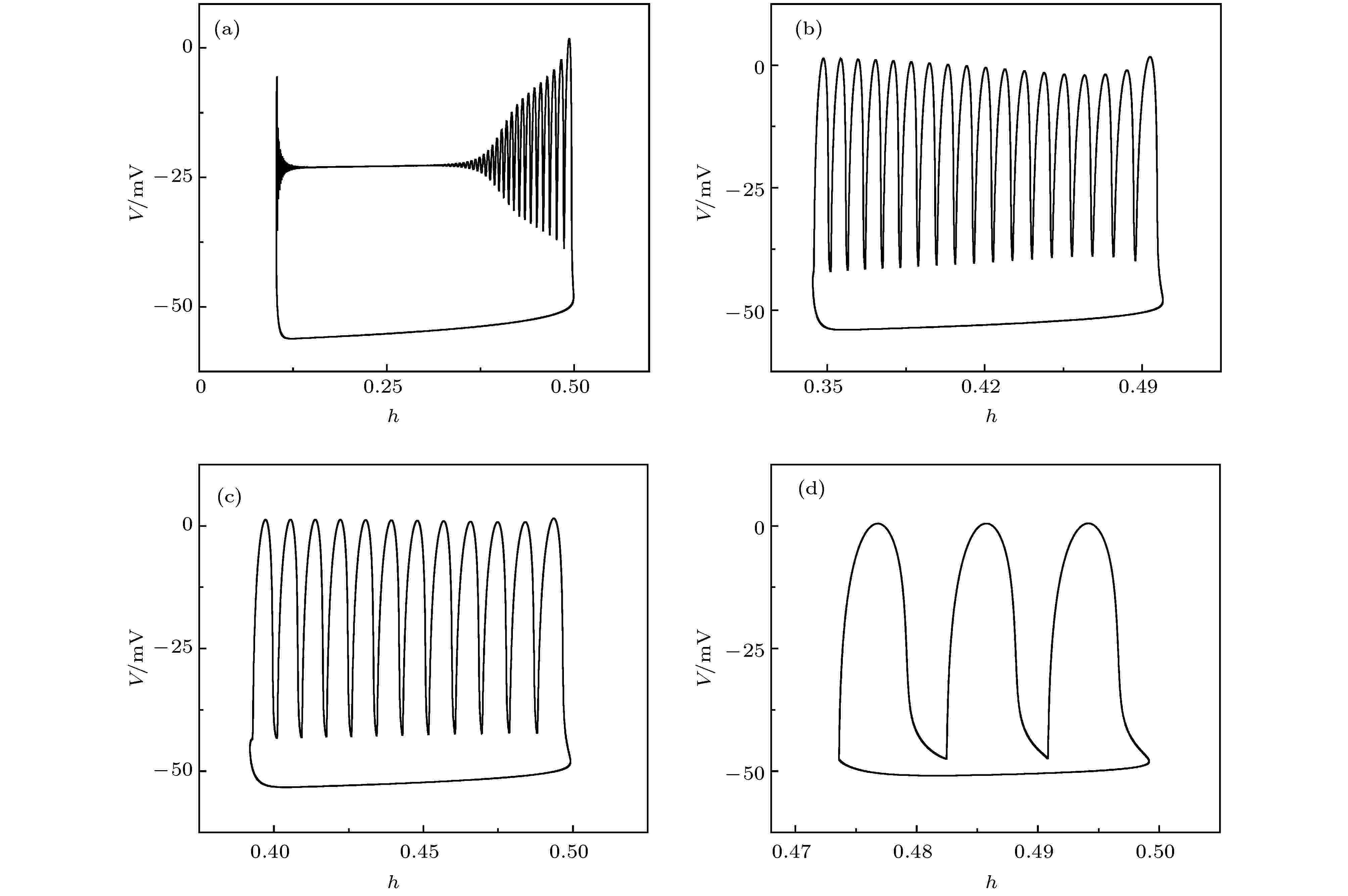
2020, 69 (4): 040501.
doi:10.7498/aps.69.20191509
Abstract +
The pre-Bötzinger complex is a neuronal network with excitatory coupling, which participates in modulation of respiratory rhythms via the generation of complex firing rhythm patterns and synchronization transitions of rhythm patterns. In the present paper, a mathematical model of single neuron that exhibits complex transition processes from bursting to spiking is selected as a unit, the network model of the pre-Bötzinger complex composed of two neurons with excitatory coupling is constructed, multiple synchronous rhythm patterns and complex transition processes of the synchronous rhythm patterns related to the biological experimental observations are simulated, and the corresponding bifurcation mechanism is acquired with the fast-slow variable dissection method. When the initial values of two neurons of the pre-Bötzinger complex are the same, with increasing the excitatory coupling strength, the theoretical model of the pre-Bötzinger complex shows complete synchronization transition processes from "fold/homoclinic" bursting, to "subHopf/subHopf" bursting, and at last to period-1 spiking. When the initial values are different, with the increases of the excitatory coupling intensity, the rhythm transition processes begin from phase synchronization behaviors including "fold/homoclinic" bursting, "fold/fold limit cycle" bursting, mixed bursting composed of "subHopf/subHopf" bursting and "fold/fold limit cycle" bursting, and "subHopf/ subHopf" bursting in sequence, and to anti-phase synchronous behavior of the period-1 spiking. The complete (in-phase) synchronous period-1 spiking for the same initial values exhibits bifurcation mechanism different from the anti-phase synchronous period-1 spiking for different initial values. The anti-phase synchronous period-1 spiking presents a novel and abnormal example of the synchronization at large excitatory coupling strength, which is different from the traditional viewpoint that large excitatory coupling often induces in-phase synchronous behavior. The results present the synchronization transition process and complex bifurcation mechanism from bursting to period-1 spiking of the pre-Bötzinger complex, and the abnormal synchronization example enriches the contents of nonlinear dynamics.
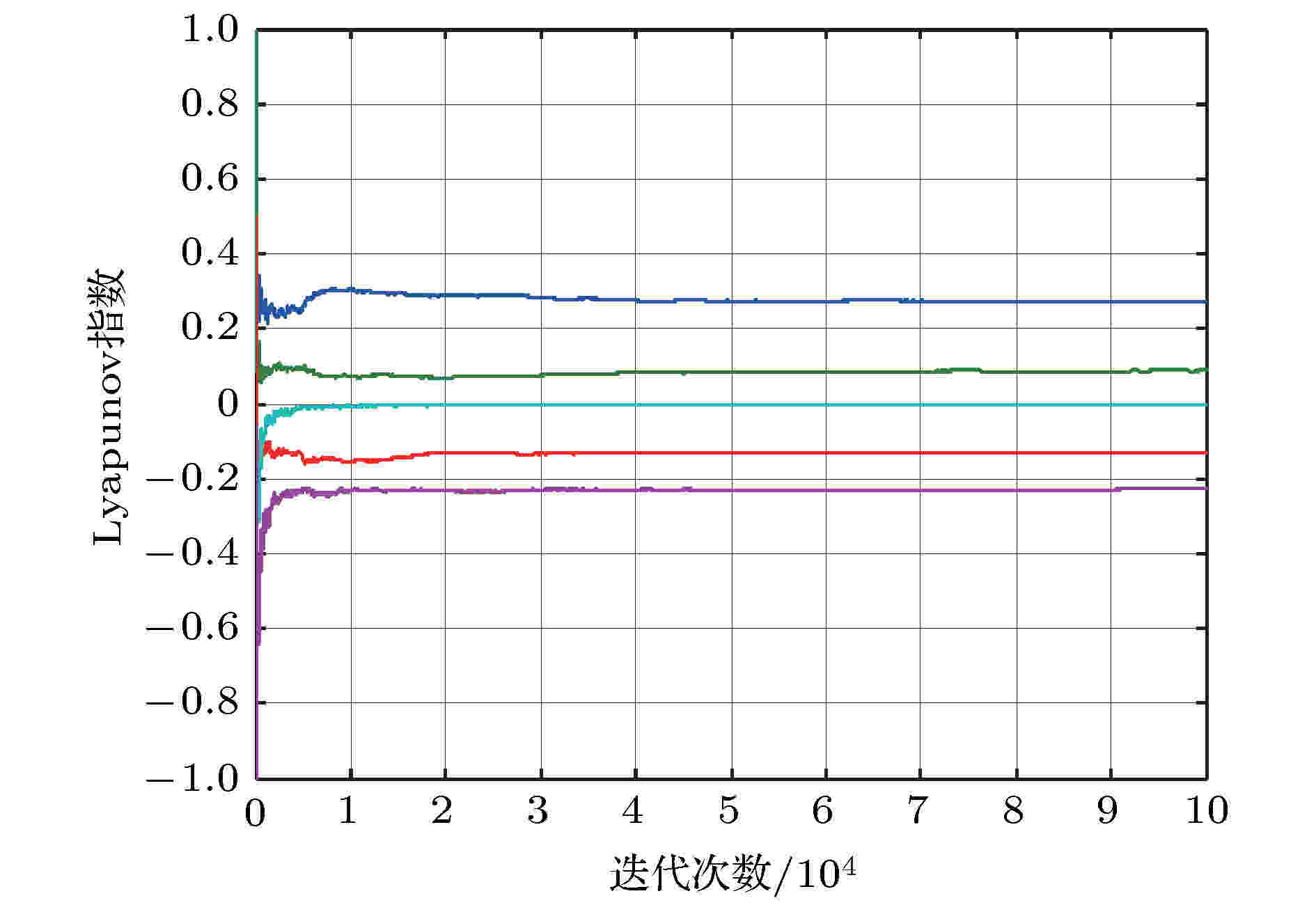
2020, 69 (4): 040502.
doi:10.7498/aps.69.20191342
Abstract +
The complex structure of hyperchaos and its complex dynamic behavior have a good application prospect in the fields of image encryption, digital watermarking and information security. Therefore, it has become very important to generate chaotic attractors with multi-vortex and multi-winged multi-rings with complex topologies. In this paper, we propose a new five-dimensional hyperchaotic system capable of generating multi-ring and multi-wing, and carry out theoretical analysis and numerical simulation experiments on some basic dynamic characteristics of the chaotic system. Such as equilibrium point, dissipation, Lyapunov exponent, bifurcation diagram, phase diagram and so on. In the process of encryption, first, we decompose the plaintext image matrix and the five chaotic sequences into an orthogonal matrix and an upper triangular matrix by QR decomposition. The five chaotic sequences generated by the chaotic system are respectively decomposed into an upper triangular matrix and a lower triangular matrix by the LU decomposition method. The upper triangular matrix decomposed by the QR decomposition method and the lower triangular matrix decomposed by the LU decomposition method are respectively added to obtain five discrete chaotic sequences. At the same time, the five discrete chaotic sequences are added to the upper triangular matrix decomposed by the LU decomposition method to obtain the final five discrete chaotic sequences. Secondly, the orthogonal matrix decomposed by the plaintext image matrix is multiplied by five orthogonal matrices decomposed by five chaotic sequences. At the same time, the elements in the upper triangular matrix decomposed by the plaintext image matrix are chaotically arranged by the chaotic sequence, and then the two matrices after the operation are multiplied. Finally, the multiplied matrix is chaotically placed on the bit by a chaotic sequence. Then use the chaotic sequence to perform a bitwise XOR operation to obtain the final encrypted image. The theoretical analysis and simulation results show that the algorithm has large key space and strong key sensitivity. It can effectively resist the attacks of statistical analysis and gray value analysis, and has good encryption effect on digital image encryption. This image encryption algorithm using a combination of conventional encryption and chaotic encryption does not have a defined plaintext ciphertext mapping relationship.
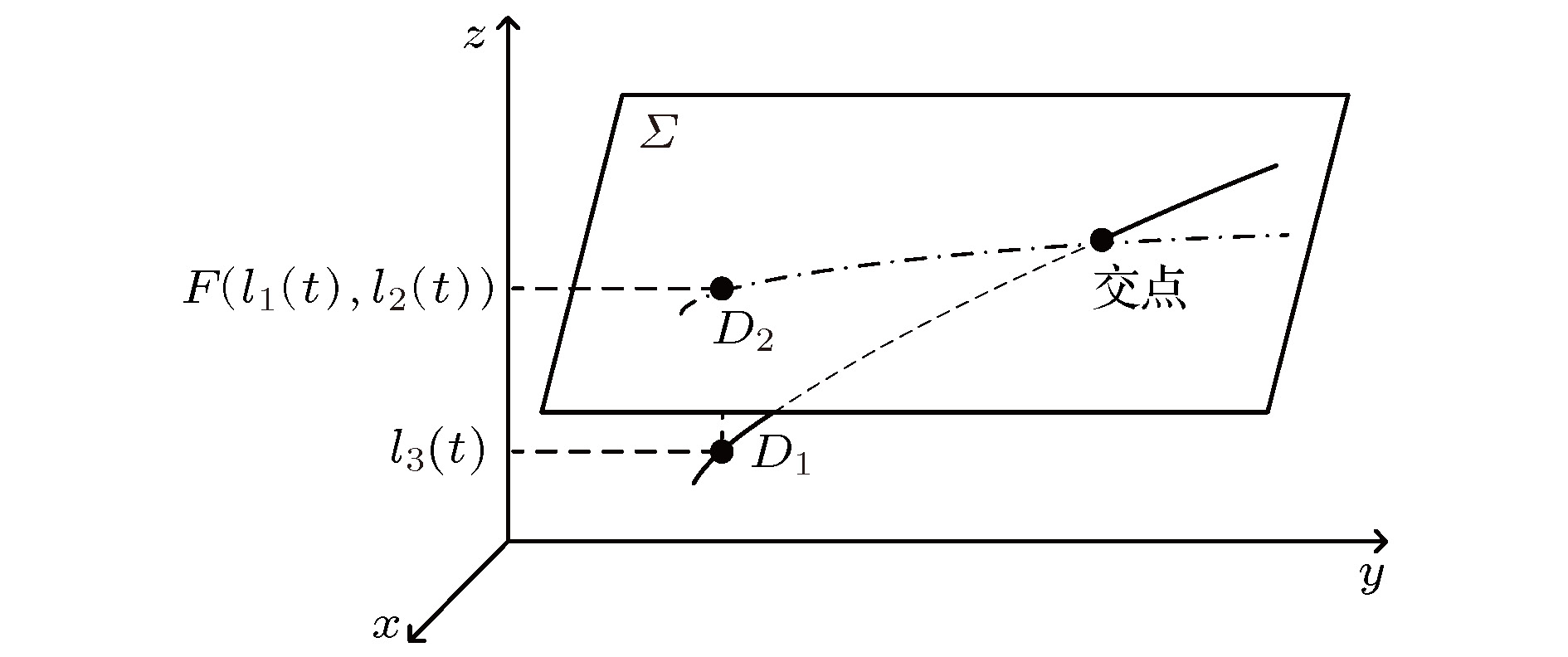
2020, 69 (4): 040503.
doi:10.7498/aps.69.20191585
Abstract +
Poincare section is an important method for analyzing nonlinear systems. Choosing a suitable plane as the Poincare section is the key to using the Poincare section to analyze a nonlinear system. At present, it is still a difficult problem to select a suitable Poincare section when analyzing a nonlinear system. This is caused by two reasons. On the one hand, the classical method for selecting a partial Poincare section only applies to analyze a part of the nonlinear system orbit, whether the selected plane is a suitable Poincare section is affected by the different initial points. On the other hand, according to the actual situation, different researchers have different needs for Poincare section. In order to solve this problem, a new method named Projection Time Domain method is put forward in this paper. This method can help us not only directly reflect the intersection between the nonlinear system orbit and the selected plane, but also accurately adjust the direction and position of the selected plane in real time. It can be used to quickly find a plane which fully intersects the nonlinear system orbit or an arbitrary plane as a Poincare section. In this paper, the complete definition of Projection Time Domain method is given firstly. Then, the principle of Projection Time Domain method is theoretically analyzed in detail. At the same time, the rules for determining whether the selected plane is a suitable Poincare section in the time domain are also studied. Finally, it is introduced how to quantify the direction and position of the selected plane in the phase space. The simulation experiments are conducted with three typical three-dimensional and four-dimensional nonlinear systems by using this new method. The experimental results consistent with the theoretical analysis, which demonstrate the effectiveness and practicability of this method.

2020, 69 (4): 040504.
doi:10.7498/aps.69.20191718
Abstract +
We theoretically study the electron transfer properties of a double quantum dot system in dissipative and pure dephasing environments based on a quantum dot contact detector. Theoretical results show that in the dissipative environment, the decoherence caused by the detector would increase the stable value of the average current and Fano factor as functions of time. Meanwhile, we find the existence of the quantum Zeno effect during the process of dynamical evolution. In the case of symmetric DQD, the relaxation caused by the dissipative environment would decrease the amplitude of the average current with time evolution and increase the value of the Fano factor in the long time limit. In the case of asymmetric DQD, the relaxation reduces the peak value of Fano factor over time. In the pure dephasing environment, we find that the frequent measurement would hinder the switch between different current channels during the cotunneling process. This results in a high value of Fano factor. In the case of symmetric DQD, increasing the pure dephasing rate would improve the value of Fano factor. In the case of asymmetric DQD, the dynamical evolution with time is not sensitive to the pure dephasing rate. In addition, it is indicated that the transfer probability of electron in the detector is only affected by the coupling between QPC and DQD. The environments have no effect on the transfer of a single electron in the detector. Our theoretical results provide theoretical references for experimental researchers to study the electron transport properties.
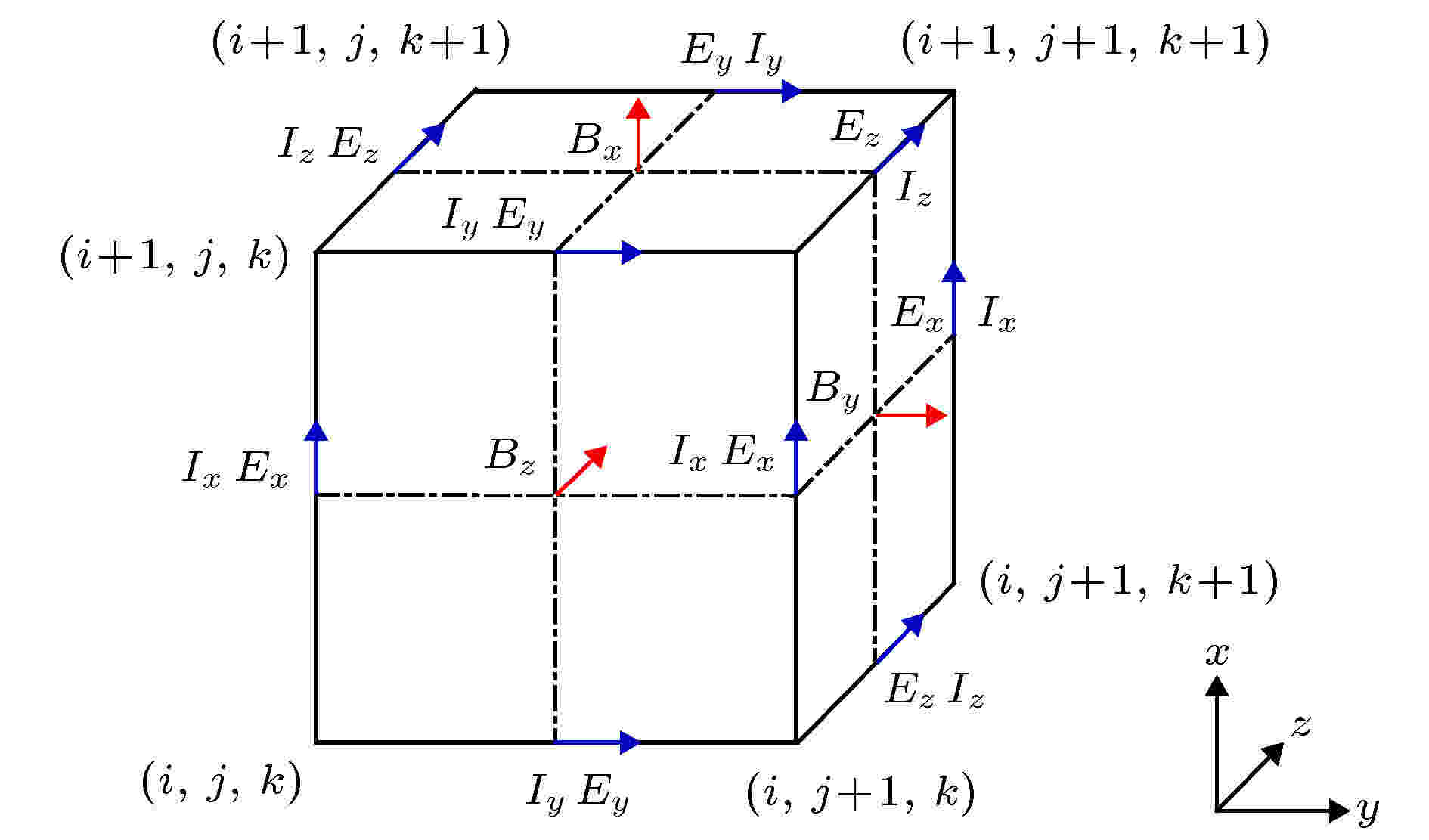
2020, 69 (4): 040701.
doi:10.7498/aps.69.20191488
Abstract +
When the working frequency of vacuum electronic device reaches the terahertz frequency, the ohmic loss has a significant impact on the vacuum electronic device. To study the effect of the ohmic loss on the working characteristic of the vacuum electronic terahertz devices, this paper implements the frequency-dependent surface impedance boundary condition (SIBC) in the 3 dimensional particle in cell code UNIPIC-3D. Conformal mesh is adopted in the code to overcome the staircase error in traditional particle in cell method. By using the surface impedance boundary, we eliminate the need to study the field inside the lossy dielectric objects which require extremely small grid cells for numerical stability. In comparison with constant parameter SIBC, the dispersive SIBC is applicable over a very large frequency bandwidth and over a large range of conductivities. The correctness of the implementation is verified by simulating the lossy resonant cavity and circular waveguide, the simulated power loss is comparable with the theoretical predication. High power vacuum electronic devices of terahertz regime are attracting extensive interests due to their potential applications in science and technologies. The impulse-wave relativistic surface wave oscillator (SWO) and low-voltage continuous-wave planar grating backward wave oscillator (BWO) both made of copper are numerically studied by using UNIPIC-3D and dispersive surface impedance boundary condition. Numerical results show that the strongest field is very close to the slow wave structure where the beam-wave interaction occurs and that terahertz wave generates both in these two devices. The distributed wall loss has a considerable effect on the devices: the output power has a significant decrease and the startup time becomes longer, but the working frequencies of the two devices keep unchanged. To improve the efficiency of relativistic SWO, a resonant reflector is proposed between the diode and the slow wave structure. Numerical results show that the working frequency of the device with a resonant reflector keeps unchanged as the original one, but the output power increases to 60 MW from 41 MW of the original one when the ohmic loss is considered.
ATOMIC AND MOLECULAR PHYSICS
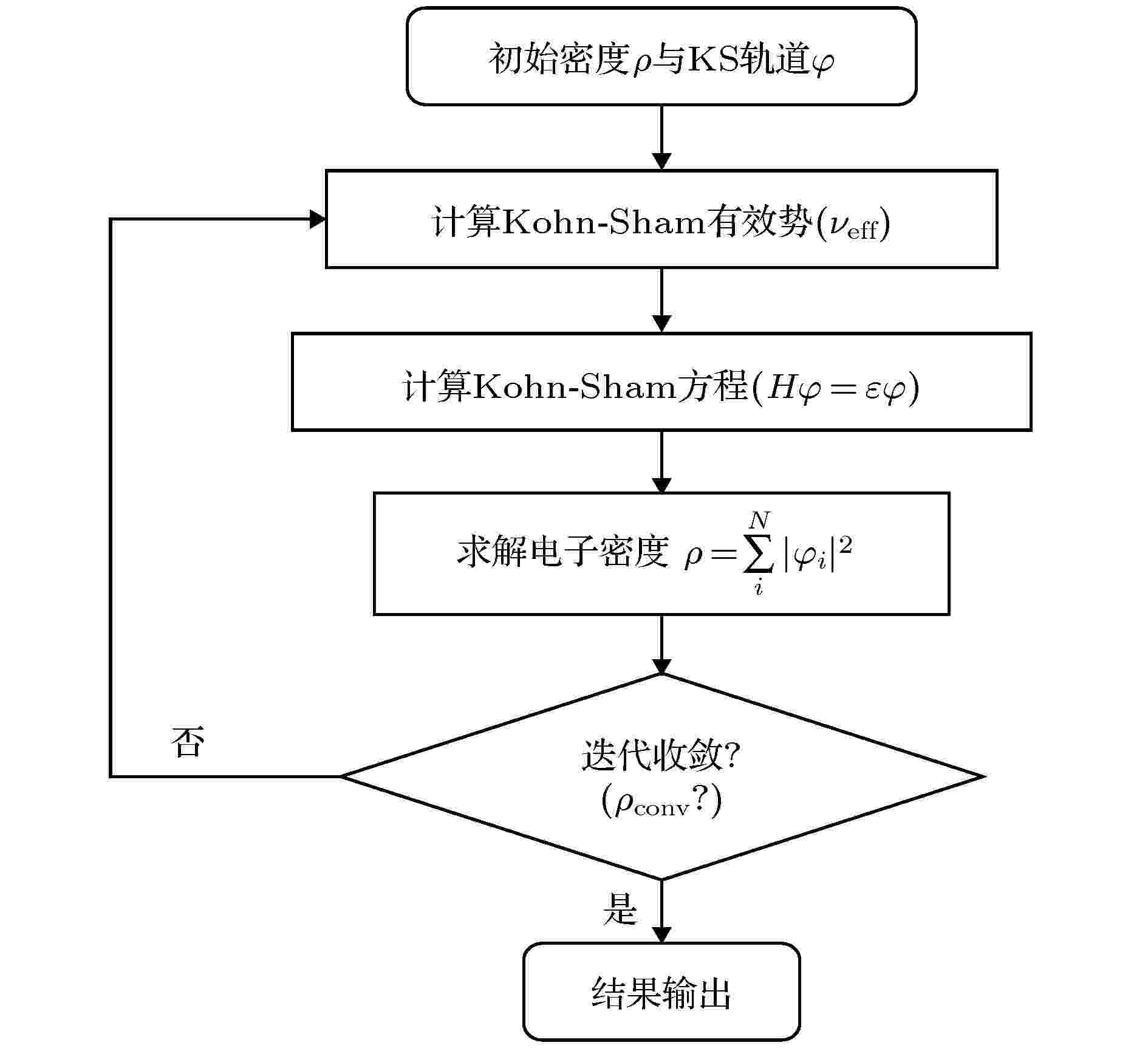
2020, 69 (4): 043101.
doi:10.7498/aps.69.20191658
Abstract +
The development of first principle methods can represent the summit of the sciences in the material computing and molecular modeling, and the corresponding first principle software packages are closely related with the accumulation of theories and algorithms in this field. In this paper, we reported our recent progress in refactoring the first principle package BSTATE. The key points in the reconstruction are lowering the doorsill, extending the scope of application, as well as adjusting package to the popular computer hardware. And as such, we updated the Makefile system to the new CMake system, in which the GUI can be used and many math libraries can be configured automatically; we added the support for the Libxc library, in which a large quantity of density functionals are included; we updated the interface for supporting GPU, in order to support the heterogeneous computing system. After refactoring, the Makefile system of BSTATE can supply both the Makefile and CMake system, and the Fourier transform libraries such as FFTW2, FFTW3, and Cufftw, the math libraries such as Intel MKL library, Openblas, and the density functional library such as Libxc, can be automatically or manually assigned. The integration of FFTW3 can slightly prompt the calculating efficiency in Intel’s many integrated core (MIC) architecture, and the integration of Cufftw can supply the initial support for the graphics processing unit (GPU) architecture, respectively. The usage of Libxc library makes the BSTATE package has the capacity to use hundreds density functionals, and the usages of various functionals were demonstrated by calculating the density of states of GaAs compound. Beyond the integration of various libraries, the parallel performance of BSTATE was also investigated. It can be found that the Fourier transformation and the solving for the eigenvalue equations are the major contributions. Using the tuning and analysis utilities (TAU) tool, we found that the tasks can be well distributed in modern HPC clusters. It implied that the refactoring didn’t affect the parallel efficiency of original BSTATE package. In a following benchmark test of graphene fragments, one can found that the refactored BSTATE package showed the best performance, its FFTW3 & Libxc version owns about 0–17% acceleration comparing to that of FFTW2 version.
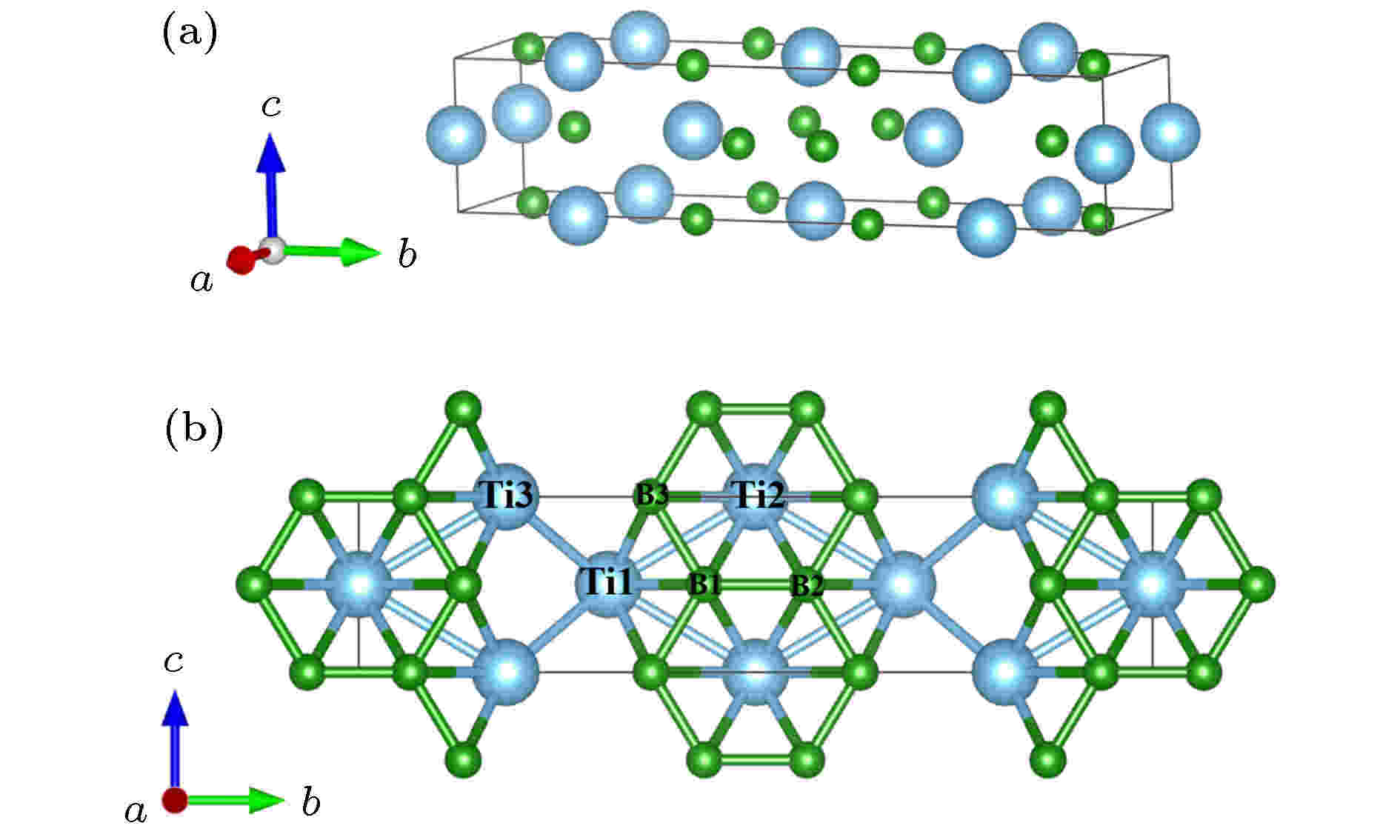
2020, 69 (4): 043102.
doi:10.7498/aps.69.20191194
Abstract +
As an important Ti-B component, Ti3B4has been widely used in industry and military applications. However, its deformation behaviors are not clear, which greatly limits its applications. First-principles methods based on density function theory were employed to investigate the mechanical, electronic properties and deformation mechanisms of Ti3B4under uniaxial compressions along different axis. The results show that the structure underwent a massive change under different axial compressions. Strong anisotropic of deformation behaviors in Ti3B4was observed. The compressive strength along b-axis is the highest in Ti3B4structure. Undera-axis compression, the interaction between intralayer Ti—Ti bonds becomes weaker as the compressive strain increases, causing the partly damage of Ti3B4. However, in this process, the structure is not destroyed and can sustain the stress continuously. After that, the interlayer Ti—Ti bonds and the intralyer B—B bonds which are alongb-axis, are broken and then it causes the sudden drop in stress, implying that the Ti3B4structure is fully destroyed. Underb-axis compression, the changes of Ti—B bonds in Ti3B4structure lead to the decrease of stress. Similarly, the structure can sustain the stress continuously in the process. Then, the B—B bonds which are alongb-axis are broken, resulting in the sudden drop in stress. Underc-axis compression, the formation of interlayer Ti—B bonds and the breakage of intralayer Ti—B bonds result in structural instability of Ti3B4. Meanwhile, the deformed Ti3B4still exhibits a metallic feature in the crystalline state after uniaxial compressions. However, there is no noticeable pseudogap in DOS spectra fora-axis andb-axis compressions. While forc-axis compression, there still exists a pseudogap around the Fermi energy, but it moves to the lower energy. And the pseudogap becomes narrower than that of the initial structure, which means that the covalent properties of Ti3B4are reduced after deformations. The present work provides necessary insights in understanding the mechanical behaviors and deformation mechanisms of Ti3B4, which is the basis for improving the mechanical performance of Ti3B4at macroscale.
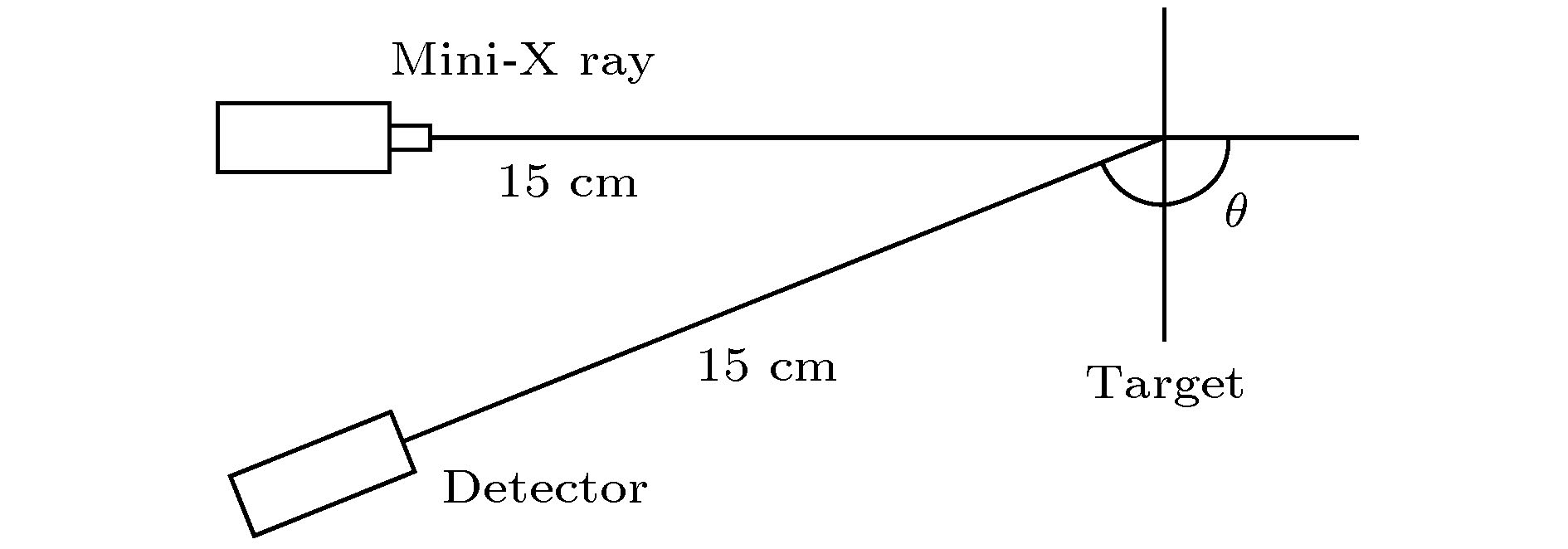
2020, 69 (4): 043201.
doi:10.7498/aps.69.20191524
Abstract +
ELECTROMAGNETISM, OPTICS, ACOUSTICS, HEAT TRANSFER, CLASSICAL MECHANICS, AND FLUID DYNAMICS
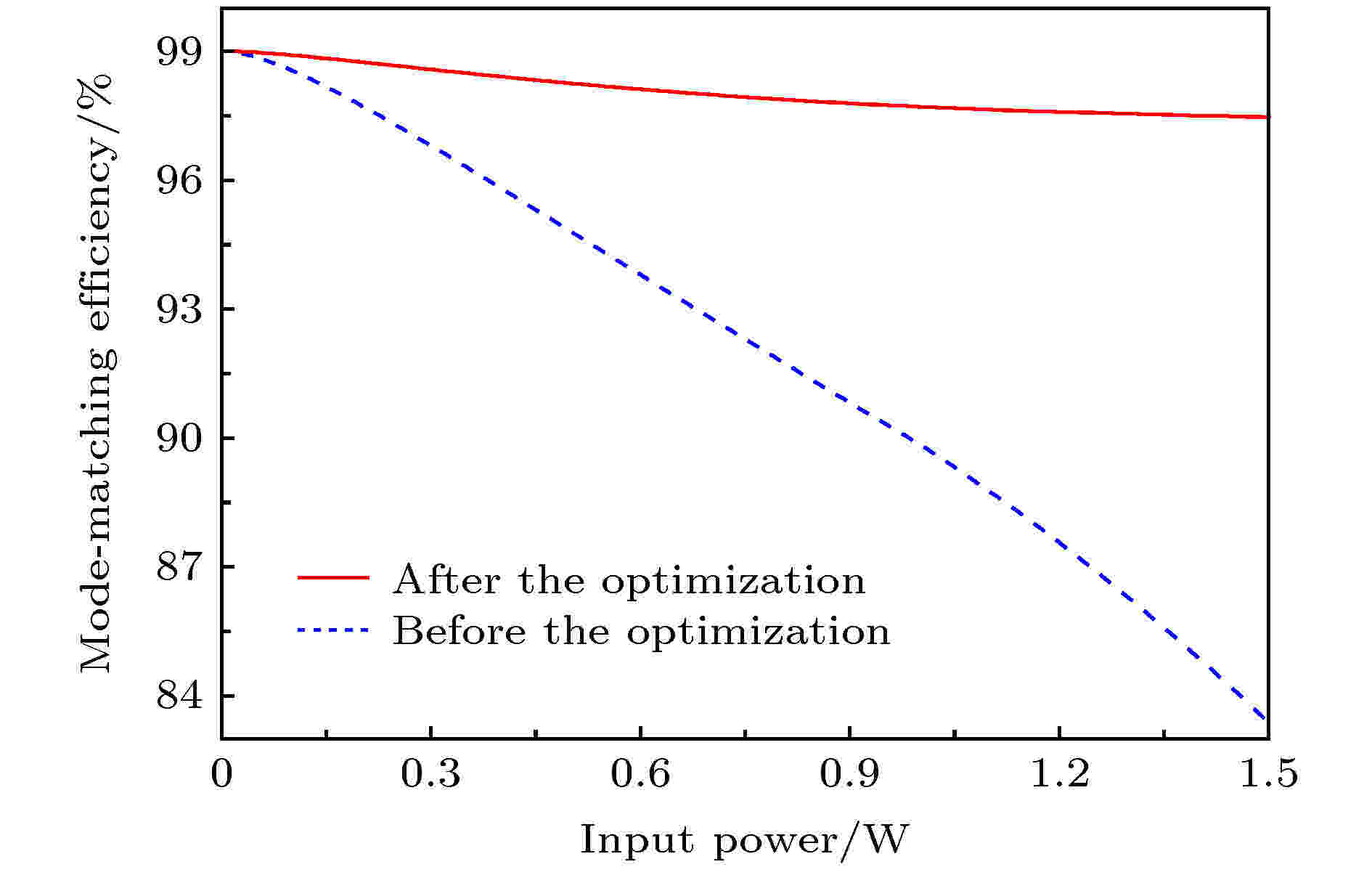
EDITOR'S SUGGESTION
2020, 69 (4): 044201.
doi:10.7498/aps.69.20191417
Abstract +
Second harmonic generation (SHG) is used to get continuous wave laser with a lot of applications, it is a major way to provide pump power for generating nonclassical states, especially for squeezed states and entanglement states. High-efficiency SHG resonant on atoms lines also provides laser sources for atomic entanglement generation, light-atom interaction and high-speed quantum memory. For the frequency-doubling process at 426 nm, the major challenge of increasing the conversion efficiency is the thermal effect caused by the absorption in crystal. The degradation of mode-match efficiency induced by the severely thermal effect limits the conversion efficiency of the second harmonic generator. Furthermore, the blue light induced infrared absorption (BLIIRA) in the nonlinear crystal intensifies the thermal effect, it makes the conversion efficiency of the frequency-doubling cavity and the stability of the output blue laser worse, and it is more serious at high input power. Based on the theoretical analysis of thermal lens, we find that the thermal lens should not be placed at the center of the crystal, the location of the equivalently thermals lens has a deviation from the center of the crystal. Follow the theoretical analysis of thermal lens, we design a ring cavity with a 10 mm-long periodically poled potassium titanyle phosphate (PPKTP) crystal to reduce the thermal lens effect induced mode-mismatch. The location of nonlinear crystal is adjusted precisely to reduce the mode-mismatch caused by the thermal lens under our theoretical analysis. Finally, we realized a high conversion efficiency blue laser at 426 nm with the conversion efficiency up to 83.1% with an output power of 428 mW after the adjustment of the crystal location, corresponding to our theoretical analysis well. The measured beam quality factors (M2value) of the generated blue laser are
$ M^2(x) = 1.05 $
and
$ M^2(y) = 1.02 $
, respectively. The measured power stability of Generated Blue laser in 15 mins is 1.25%. The output power of the SHG is strong enough to provide pump power for the generation of the continuous variable squeezed vacuum state at 852 nm and the long-term stability of the output blue laser is also measured to be fine. To the best of our knowledge, the conversion efficiency is the highest-reported one at this wavelength. We believe that such high-performance frequency doubling system is a fundamental building block for quantum information science based non-classical states.

EDITOR'S SUGGESTION
2020, 69 (4): 044202.
doi:10.7498/aps.69.20191350
Abstract +
It is important to control the femtosecond laser filamentation and the supercontinuum (SC) for their potential applications. The use of axicon is beneficial to the filamentation elongation and SC enhancement, because the axicon can convert the incident laser into a Bessel beam and forms a unique longer depth of focus region. On the other hand, the flattened laser beam which has a uniform distribution of the beam intensity, can propagate in condense media with a higher incident energy than that of Gaussian laser beam. It has unique advantages in forming a SC with high energy and high conversion efficiency. In this paper, we combine the use of axicon and the flattened laser beam to form filament and SC in fused silica. First, we study the filamentation generated by the Gaussian beam and the flattened beam, respectively, with the same incident pulse energy (672 μJ). The results show that the flattened beam can generate filament with relative uniform intensity distribution in the focal depth of the axicon and the intensity is relatively smaller than that of the Gaussian beam. It suggests that the flattened laser beam can propagate in fused silica with a higher energy than Gaussian beam. Second, we study the filamentation of the flattened beam of 1.319 mJ. In this case, the filament intensity is close to that of the Gaussian beam with 672 μJ. Moreover, the filamentation of the flattened beam with 1.319 mJ is longer and the intensity distribution is more uniform than that of the Gaussian beam with 672 μJ. Therefore, a flattened laser beam can generate the SC with a higher energy than that of the Gaussian beam in fused silica. The comparison of the spectra shows that the relative spectral intensity of flattened beam with 1.319 mJ in the range of 550–700 nm is much higher than that of the Gaussian beam with 672 μJ. The conversion efficiency of the Gaussian beam and the flattened beam is 32.58% and 39.59%, respectively. It can be seen that the flattened laser beam has advantages not only in generating long and uniform filament, but also in generating the intense SC. This approach is helpful to many applications, such as white light LIDAR and micro-nano processing.

2020, 69 (4): 044203.
doi:10.7498/aps.69.20190834
Abstract +
Polarization is a property of vector beam that is widely used in many areas of science and technology. And vector beam is also called polarization vortex beam. Radially polarized beam and azimuthally polarized beam are the paradigm of vector beam. Extreme ultraviolet (EUV) vector beam could be applied in many fields such as diffractive imaging, Extreme Ultraviolet Lithography (EUVL), or ultrafast control of magnetic properties. In our experiments, a home-made EUV spectrometer was used to generate a tunable ultrafast EUV coherent light source based on high-order harmonic generation (HHG) by intense femtosecond laser. The apparatus features by using the plane grating in conical diffraction. The radially polarized vector beam and Gaussian beam with 800 nm, 35 fs laser pulses were applied to interact with Argon atoms, respectively. The high harmonic spectrums with a polarization singularity and a Gaussian distribution were observed. The experimental results demonstrate that the EUV vector beam could be transfered from near-infrared driven laser during the highly nonlinear interaction. The short-wavelength radiation with a polarization singularity can reach a photon flux of 108per second. And the harmonic orders produced by Gaussian beam are significantly higher than that of vector field. The mechanism of macroscopic phase matching was discussed. It indicates that the phase matching for vector harmonic yields is similar with that driven by a Gaussian beam. In this case, EUV vector beam through HHG has been obtained, which provides one important method for attosecond vector pulses and opens new possibilities for exploring and manipulating the time-dependent evolution of quantum states in atom and molecule.
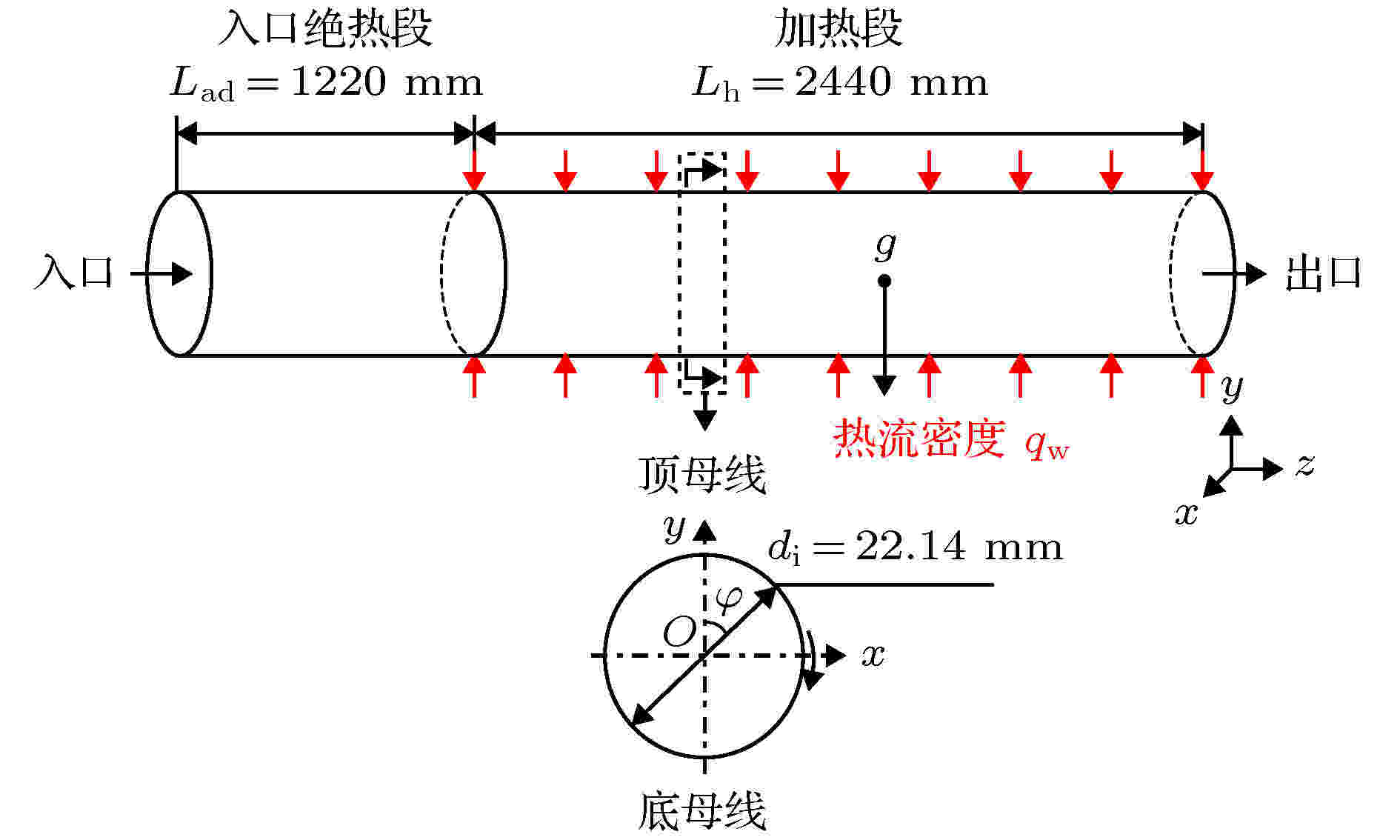
2020, 69 (4): 044401.
doi:10.7498/aps.69.20191513
Abstract +
In the present study, the three-dimensional steady-state numerical simulation has been performed by using ANSYS Fluent15.0 with SSTk-ωlow Reynolds turbulence model to study flow and heat transfer characteristics for supercritical CO2in the horizontal straight tube with inner diameterdi= 22.14 mm and heating lengthLh= 2440 mm under heating condition. The reliability and accuracy of the numerical model was verified by the experimental data of flow and heat transfer of supercritical CO2in horizontal tube. Firstly, flow and heat transfer characteristics of supercritical CO2was studied in horizontal tube. Based on the assumption that the supercritical CO2will undergoes “phase transition” between liquid-like and vapor-like at pseudocritical temperatureTpc, the differences between top generatrix and bottom generatrix of horizontal tube at flow and heat transfer behaviors were revealed. The results show flow and heat transfer characteristics of supercritical CO2in horizontal tube are similar to those under subcritical pressure. Then, the influences of heat fluxqwand mass fluxGon flow and heat transfer of supercritical CO2were analyzed. The higher heat fluxqwis or the smaller mass fluxGis, the higher inner wall temperatureTw,iat top generatrix is. The reasons for difference in the distribution of inner wall temperatureTw,iat top generatrix under different heat fluxqwand mass fluxGwere explained by capturing detailed information about thermophysical properties distribution including specific heat at constant pressurecpand thermal conductivityλ, axial velocity distribution and turbulent kinetic energy distribution in the fluid domain. It is observed that vapor-like film thicknessδ, vapor-like film property characterized by specific heat at constant pressurecpand thermal conductivityλ, axial velocityuand turbulent kinetic energykare the main factors affecting the difference in inner wall temperature distribution at top generatrix. The present work can provide a theoretical guidance for design and safe operation of heat exchanger for supercritical CO2Brayton cycle.
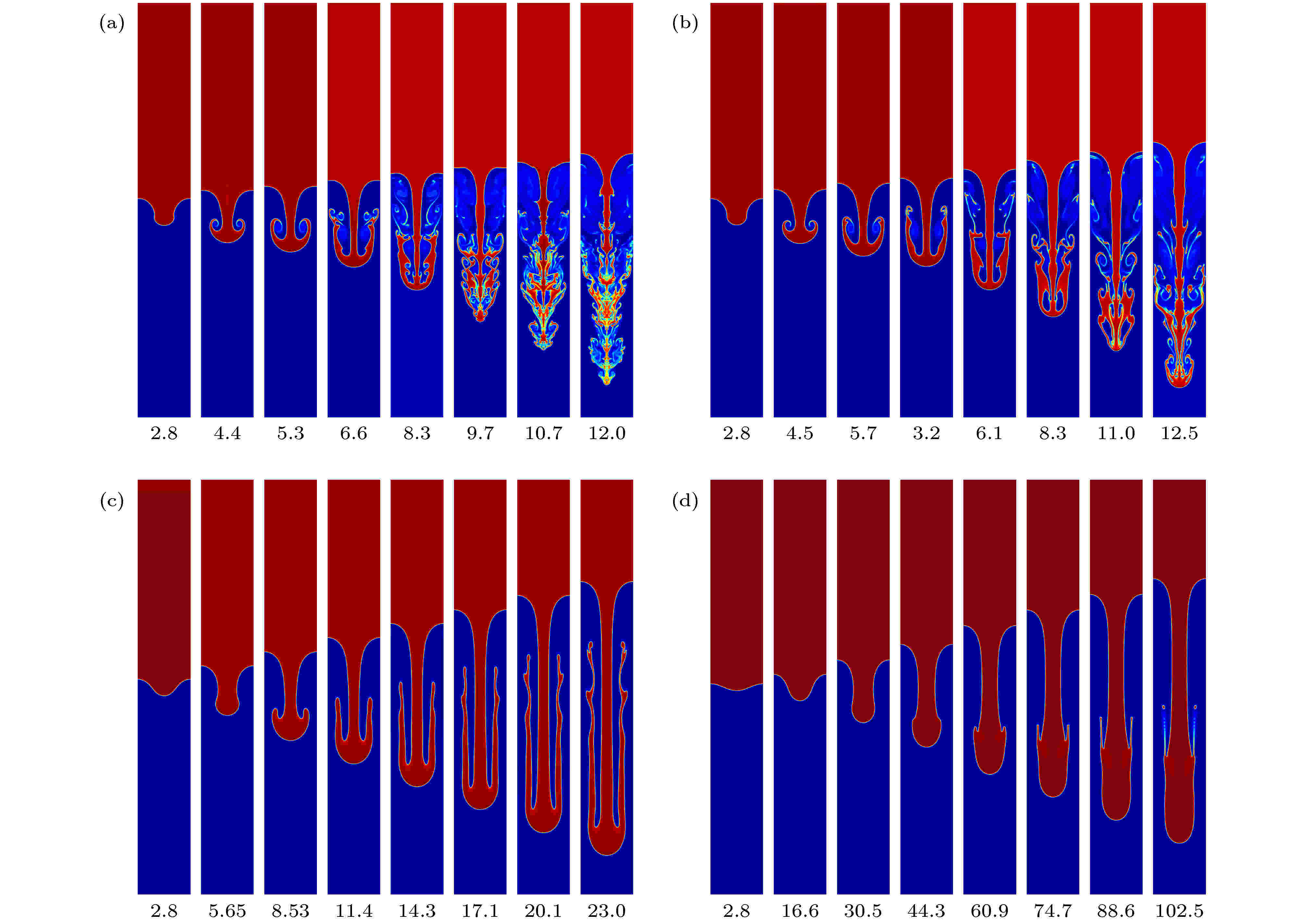
2020, 69 (4): 044701.
doi:10.7498/aps.69.20191504
Abstract +
In this paper, an advanced phase-field lattice Boltzmann method based on the multiple-relaxation-time collision model is used to simulate the immiscible single-mode Rayleigh-Taylor instability with a moderate Atwoods number in a long tube, and we systematically analyze the effect of the Reynolds number on the interfacial dynamics and the late-time development stages of interface disturbance. The highest Reynolds number in the current simulation reaches up to 10000. The numerical results show that the Reynolds number significantly affects the development of the instability. For high Reynolds numbers, the instability undergoes a sequence of different growth stages, which include the linear growth, saturated velocity growth, reacceleration, and chaotic mixing stages. In the linear growth stage, the developments of the bubble and spike conform to the classical linear growth theory, and it is shown that the growth rate increases with the Reynolds number. In the second stage, the bubble and spike evolve with the constant velocities, and the numerical prediction for spike velocity is found to be slightly larger than the solution of the potential flow theory proposed by Goncharov [Phys. Rev. Lett.200288134502], which can be attributed to the formation of vortices in the proximity of the spike tip. In addition, it is found that increasing the Reynolds number reduces the bubble saturated velocity, which then is smaller than the solution of the potential model. The nonlinear evolutions of the bubble and spike induce the Kelvin–Helmholtz instability, producing many vortex structures with different scales. Due to the interactions among the vortices, the instability eventually enters into the chaotic mixing stage, where the interfaces undergo the roll-up at multiple layers, sharp deformation, and chaotic breakup, forming a very complicated topology structure. Furthermore, we also measured the bubble and spike accelerations and find that the dimensionless values fluctuates around the constants of 0.045 and 0.233, indicating a mean quadratic growth. And for low Reynolds numbers, the heavy fluid will fall down in the form of the spike, and the interface in the whole process becomes very smooth without the appearances of the roll-up and vortices. The late-time evolutional stages such as the reacceleration and chaotic mixing cannot also be observed.

2020, 69 (4): 044702.
doi:10.7498/aps.69.20191711
Abstract +
Studies on hydrodynamic characteristics of viscous incompressible flows around flexible hydrofoils are of practical importance for the design and performance optimization of marine structures such as ship rudders and stabilizing fins. The aim of this paper is to extend a radial basis function based ghost cell method to simulate flows around single or multiple flexible moving hydrofoils in array arrangement. The numerical model is based on a ghost cell finite difference method for considering the influence of the immersed boundaries on the flow. Also, a compact supported radial basis function (CSRBF) is introduced to track the complex flexible boundary with some controlling points of the body surface. Based on the present method, the uniform flow around a flexible hydrofoil swimming like a fish is simulated. Good grid convergence of drag and lift coefficients demonstrates the accuracy and reliability of the present method. Also, the hydrodynamics patterns of the flexible hydrofoil under different oscillation frequencies are studied. Further, the thrust generation mechanism of the hydrofoil is explained. Afterwards, flows around the undulating hydrofoils in array arrangement are simulated. The force coefficients and wake patterns under different distances and oscillation frequencies are investigated. It is observed that the thrust coefficients of the hydrofoils under narrow arrangement and high oscillation frequencies have significant amplification effects. In addition, the critical frequency at zero thrust reduces.
CONDENSED MATTER: STRUCTURAL, MECHANICAL, AND THERMAL PROPERTIES
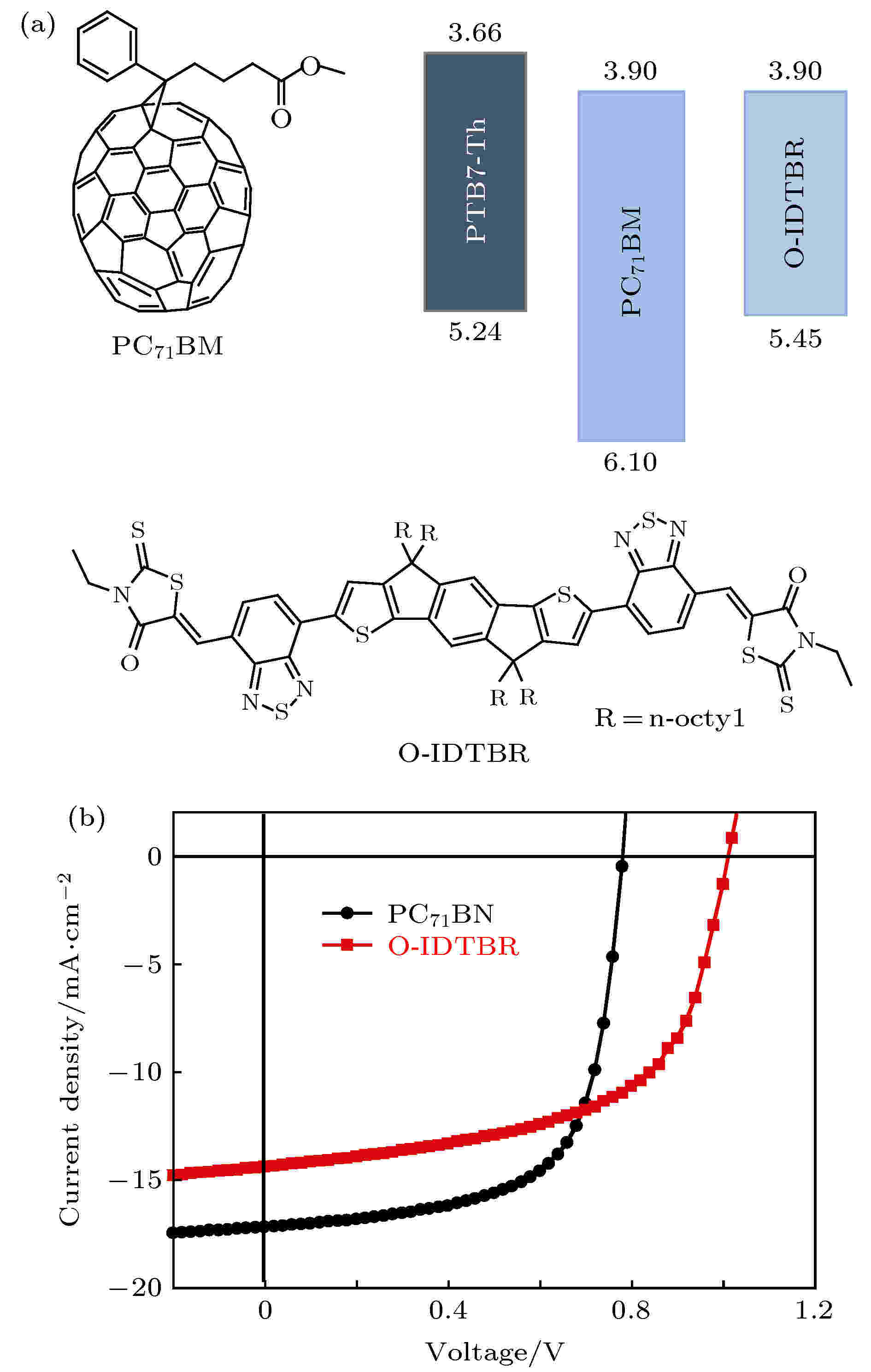
2020, 69 (4): 046101.
doi:10.7498/aps.69.20191699
Abstract +
Charge carrier recombination and energy disorder in organic solar cells both have a profound impact on the open-circuit voltage of the device. In this paper, both traditional fullerene-(PC71BM) and nonfullerene-(O-IDTBR) based solar cells were fabricated using the same electron donor material (PTB7-Th). The room-temperature current density–voltage characteristics showed that despite the values of their power conversion efficiencies were very close, there was a huge open circuit voltage (Voc) difference between the PC71BM and O-IDTBR devices. To understand the sources of theVocvariation, characterization techniques such as impedance spectra, low temperature electrical characterization method, transient photovoltage, and electroluminescent spectra were carried out. Temperature-dependentVocof the devices were measured in a large temperature range between 120 K and 300 K. The charge transfer state energy (ECT
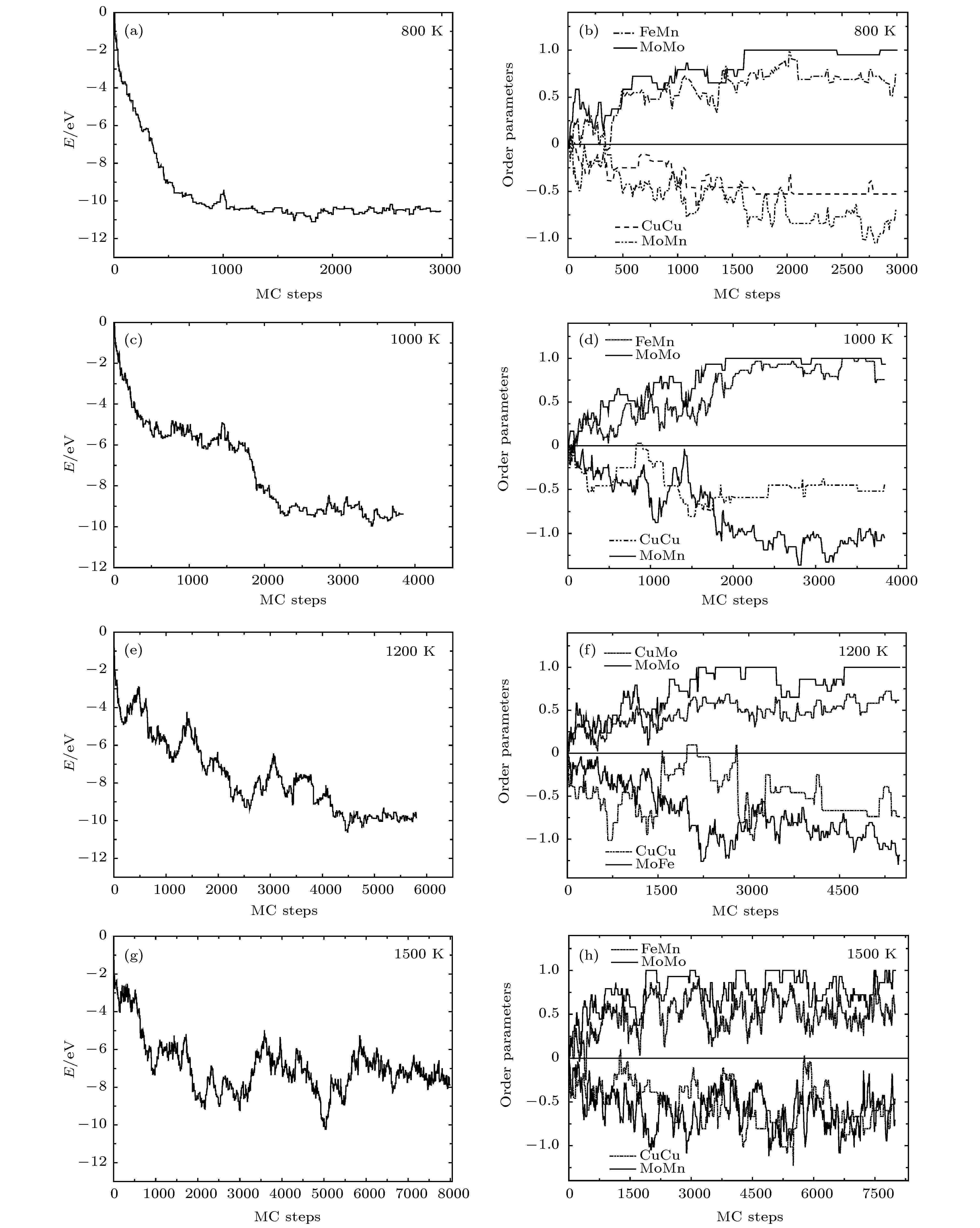
EDITOR'S SUGGESTION
2020, 69 (4): 046102.
doi:10.7498/aps.69.20191671
Abstract +
The prediction of stable state of high-entropy alloys (HEAs) is crucial to obtain fundamental insight to the excellent properties of HEAs. Taking a FeCuCrMnMo alloy as a case study, we combined Monte Carlo (MC) method with the density functional thoery (DFT) calculations (MC/DFT) to predict the equilibrium structure of high-entropy alloys in a finite unit cell. Instead of approaching the ideal random state obtained from special quasi-random approximation (SQS) method, physical factors such as atomic size, mixing enthalpy of atomic pairs, and interatomic interactions in the alloy are fully considered and implemented in our simulation by MC/DFT calculations. MC codes ensure the energy convergence of the system to the equilibrium state through the atom exchange process. The equilibrium structures exhibit Cu-rich short-range orders (SRO), which is consistent with the observation in experiments. Comparing with ideal random state structure, SRO structure is more stable in energy, and more closely packed in atomic arrangement. Moreover, the analyses of order parameters and radial distribution functions (RDFs) are performed to character the structure of high-entropy alloy. The order parameter of Cu-Cu atomic pair reaches to –0.53 in the SRO equilibrium structure, which indicates that Cu-rich regions appear in the alloy. The RDFs show that the atomic distance distribution of the SRO structure is between 2.25 Å to 2.7 Å, which is smaller than the range of 2.16 Å to 2.84 Å in the SQS structure, indicating that the lattice distortions is relatively small in the SRO structure after structural optimization. The appearing of SRO phenomena is attributed to the inherent characteristics of atoms, including (i) atomic size, (ii) interatomic mixing enthalpy and (iii) the interaction of atoms. Atomic sizes in the FeCuCrMnMo alloy are in the order of Fe (11.78) < Cu (11.81) < Cr (11.97) < Mn (14.38) < Mo (15.58), in unit of Å3/atom. The relatively large sizes of Mn and Mo atoms should disadvantage the pairing of Mo-Mo and Mn-Mn. The mixing enthalpy of Cu with other atoms are all positive values, indicating that Cu is not favor of pairing other elements and precipitate itself. The analyses of density of state (DOS) and Crystal Orbital Hamilton Population (COHP) also support the results. The reason is exactly attributed to the inactive valence electrons of Cu. Furthermore, the effect of SRO on the magnetic and mechanical properties are investigated. The existence of SRO decreases the mean value of magnetic moment, and results in an increase of elastic moduli (B,GandE) and a decrease in the ductility and anisotropy properties.

2020, 69 (4): 046103.
doi:10.7498/aps.69.20191069
Abstract +
Tungsten (W) is a potential candidate for plasma facing materials (PFMs) of fusion reactor. The helium (He) produced in fusion reaction is insoluble and easy to gather and form to He bubbles in W, resulting in embrittlement and degradation of the performance of the W matrix. In this paper, based on molecular dynamics, the nucleation and growth of helium bubbles in the bulk and at ∑3[211](110) and ∑9[110](411) grain boundaries of W was studied. As a result, the growth mechanism of Helium bubbles at grain boundary of W was different from in bulk. Helium bubbles in bulk W grow up by extruding dislocation rings. The growth mechanism of helium bubbles at ∑3[211](110) grain boundary was as follows: Firstly, a small amount of W interstitial atoms were extruded and emitted. And then the 1/2
$\left\langle {111} \right\rangle $
dislocation line was extruded. Finally, the 1/2
$\left\langle {111} \right\rangle $
dislocation line would migrate along the direction of [111] of the grain boundary interface. Moreover, the emission of W interstitial atoms and dislocation extrusion of the helium bubble were not observed in our simulated time scale at the ∑9[110](411) grain boundary. Then we used the NEB method to calculate the diffusion barrier of self-gap atoms in the bulk and at ∑3[211](110) and ∑9[110](411) grain boundaries of W, which explained the simulation results. The migration energy barrier of W self-gap atoms in the bulk and at ∑3[211](110) grain boundary was only a few to a few millielectron volts. So as long as W self-gap atoms dissociated from the surface of the He bubble in the thermal relaxation process, they can be easily migrated out. However, The migration energy of the W self-gap atom at the ∑9[110](411) grain boundary can be from a few tenths to a few electron volts. Even during the thermal relaxation process, the W self-gap atoms dissociated from the surface of the He bubble. It was difficult for the W self-gap atoms migrated out. Finally, the correlation between He bubble size and stress released was given. Either in bulk or at ∑3[211](110) and ∑9[110](411) grain boundaries of W, after the pressure of the helium bubble becomes stable with time, the radius of the helium bubble would increase rapidly whenever the pressure dropped sharply. So there was a small step on the curve of the evolution of the radius of the helium bubble with time. Thus, helium bubbles in W could promote growth by releasing pressure intermittently.
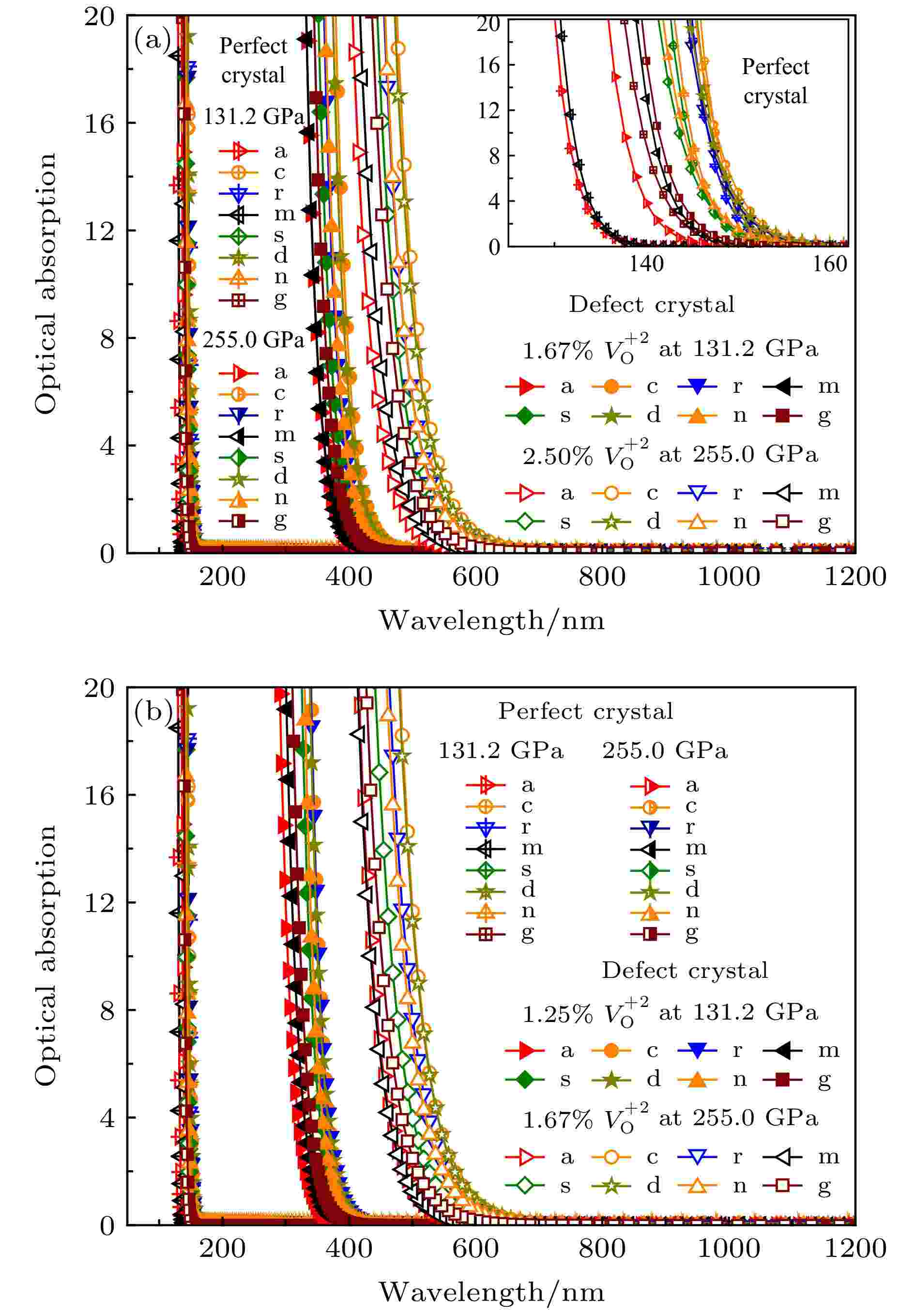
2020, 69 (4): 046201.
doi:10.7498/aps.69.20190955
Abstract +
Sapphires (Al2O3) is an important ceramic material with extensive applications in high-pressure technology and geoscience. For instance, it is often used as a window material in shock-wave experiments. Consequently, understanding the behavior of its transparency change under shock compression is crucial for correctly interpreting the experimental data. Sapphire has excellent transparency at ambient conditions, but its transparency is reduced under shock loading. This shock-induced optical extinction phenomenon in Al2O3has been studied experimentally and theoretically a lot at present, but the knowledge on the crystal-orientation effects of the extinction is still insufficient. the experimental investigations at low-pressure region (within 86 GPa) have indicated that the shock-induced extinction in Al2O3is related to its crystal orientation, but it is not clear whether the correlation also exists at high-pressure region (~131–255 GPa). Here, to investigate this question, we have performed first principles calculations of the optical absorption properties of a-, c-, d-, r-, n-, s-, g- and m-oriented Al2O3crystals without and with
$V_{\rm O}^{ + 2}$
(the +2 charged O vacancy) defects at the pressure range of 131–255 GPa. It is found that: 1) there are obvious crystal-orientation effects of the extinction in shocked Al2O3at high-pressure region, and they strengthen with increasing pressure; 2) shock-induced
$V_{\rm O}^{ + 2}$
defects could play an important role in determining these crystal-orientation effects, but the influences of pressure and temperature factors on them are relatively weak. A further analysis shows that, at the wavelength range adopted in shock experiments, the extinction of a-orientation is the weakest (the best transparency), the extinction of c-orientation is the strongest (the worst transparency), and the extinction of s-orientation is between them; at the same time, the extinction of m-orientation is similar to that of a-orientation, the extinction of r-, n- and d-orientations is close to that of c-orientation, and the extinction of g-orientation is weaker than that of s-orientation. In view of this, we suggest that the a- or m-oriented Al2O3is chosen as an optical window in shock-wave experiments of the high-pressure region. Our predictions could be not only helpful to understand further the optical properties of Al2O3at extreme conditions, but also important for future experimental study.

2020, 69 (4): 046401.
doi:10.7498/aps.69.20190970
Abstract +
Molecular dynamics (MD) simulation and first-principles calculation were used to study the heredity characteristics, evolution trend and structural stability of basic clusters during the rapid solidification of Pd82Si18alloy. The local atomic structures were characterized by the pair distribution function g(r) and the extended cluster-type index method (CTIM). The MD simulations reveal that the number of bi-cap Archimedes anti-prism (BSAP) clusters with CTIM index (10 2/1441 8/1551) is dominant in the amorphous solids rather than three-cap triangular prism(TTP) with CTIM index (9 3/1441 6/1551), which is identified be the most popular basic units in Pd82Si18alloys analyzed by Voronoi index Relative to other basic clusters, the Si-centered BSAP possesses much larger fraction in the glassy state of Pd82Si18alloys. Different from the findings in Cu-Zr alloys, the Si-centered BSAP instead of icosahedra has a larger hereditary fraction than any other Kasper clusters. During the solidification, it was found that most of the other Si-centered basic clusters are transferred into BSAP. Via the DFT calculations, it is observed that the Si-centered basic clusters with higher fraction of heredity and possesses lower binding energy. Among of them, BSAP always keeps lower binding energy than any other Si-centered Kasper clusters during the rapid solidification, resulting in its highest structural stability and the largest heredity fraction.
CONDENSED MATTER: ELECTRONIC STRUCTURE, ELECTRICAL, MAGNETIC, AND OPTICAL PROPERTIES
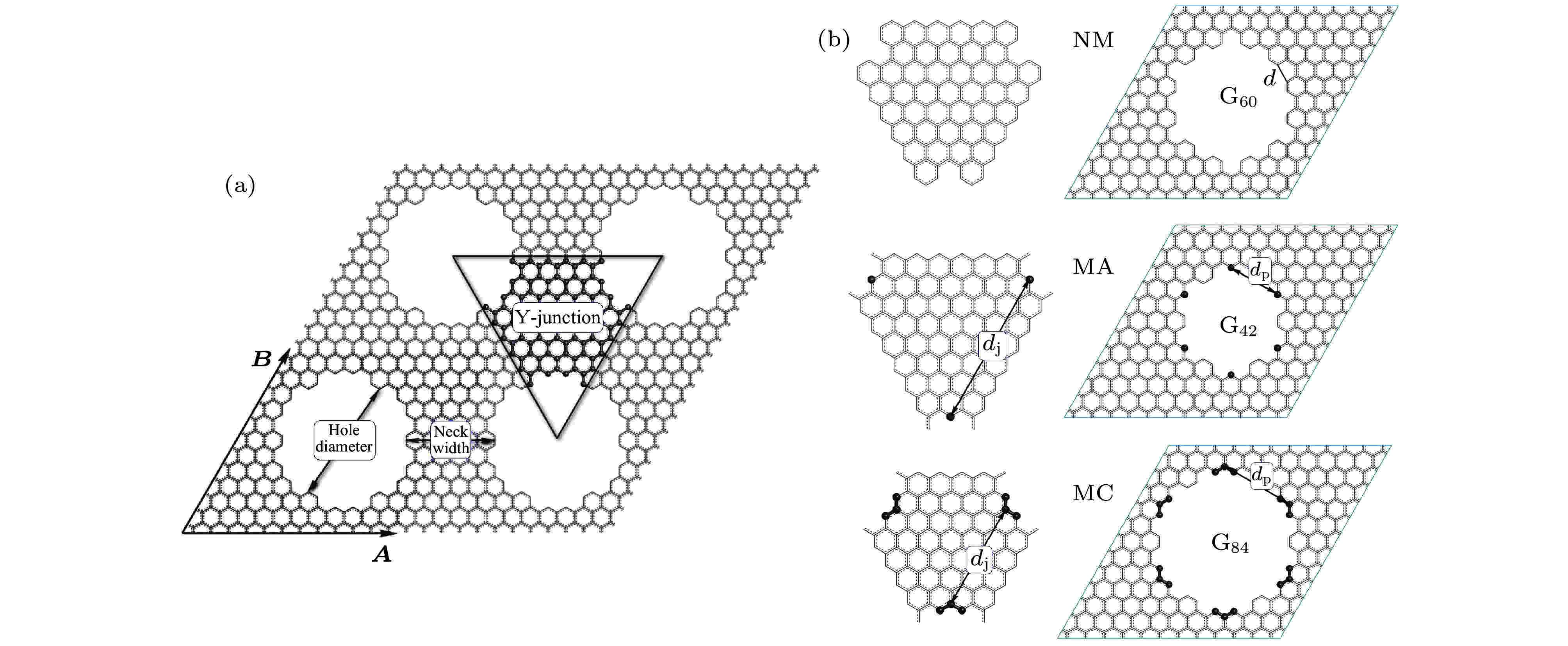
2020, 69 (4): 047101.
doi:10.7498/aps.69.20190657
Abstract +
By means of first-principles electronic structure calculations, the ordered graphene nanomeshes with patterned hexagonal vacancy holes are theoretically studied to explore the modification mechanism of electrical conduction on graphene atomic monolayers. According to pseudopotential plane wave first-principles scheme based on density functional theory, the band structures of graphene nanomeshes are calculated to analyze the electrical conductance in correlation with the superlattice symmetry and vacancy hole magnetism. Based on the structural features and topological magnetism of Y-shaped nodes between the nanopores on the atomic monolayer of graphene, the graphene nanomeshes are classified into three types. The quadruplet degeneracy and splitting of electronic states at Brillouin zone center are investigated by comparing the band structures of graphene nanomeshes and analogical superlattices. The effects of inversion symmetry and supercell size on the opening band-gap at Dirac cone are elaborately analyzed with the consideration of antiferromagnetic coupling and hydrogen passivation at the magnetic edge of nanopores on graphene nanomeshes. The band-structure calculation results indicate that the (3m, 3n) (mandnare integers) superlattices have fourfold degenerate electronic states at center point of Brillouin zone, which can be effectively splitted by regularly arranging porous atomic vacancy to make the (3m, 3n) nanomesh, resulting in adjustable band-gap no matter whether or not the sublattices keeping in equivalence. In the nanomeshes formed by patterned holes with magnetic edge, the antiferromagnetic coupling adds a quantum parameter to the inversion symmetry so as to break the sublattice equivalence, opening band-gap at the twofold degenerateKpoint. Nevertheless, the hydrogen passivation at the edge of magnetic nanopores will convert the magnetic graphene nanomeshes into non-magnetic and eliminate the band-gap atKpoint. The band-gap of graphene nanomeshes could also be controlled by changing the density of nanopores, suggesting a graphene nanomaterial with adjustable band-gap that can be designed by controlling the mesh pore spacing. The graphene nanomeshes represent a new mechanism of forming band-gap and thus promise a strategy for achieving special electrical properties of graphene nanostructures. These results also theoretically demonstrate that the nano-graphene is a prospective candidate with flexibly adjustable electrical properties for realizing multivariate applications in new-generation nano-electronics.
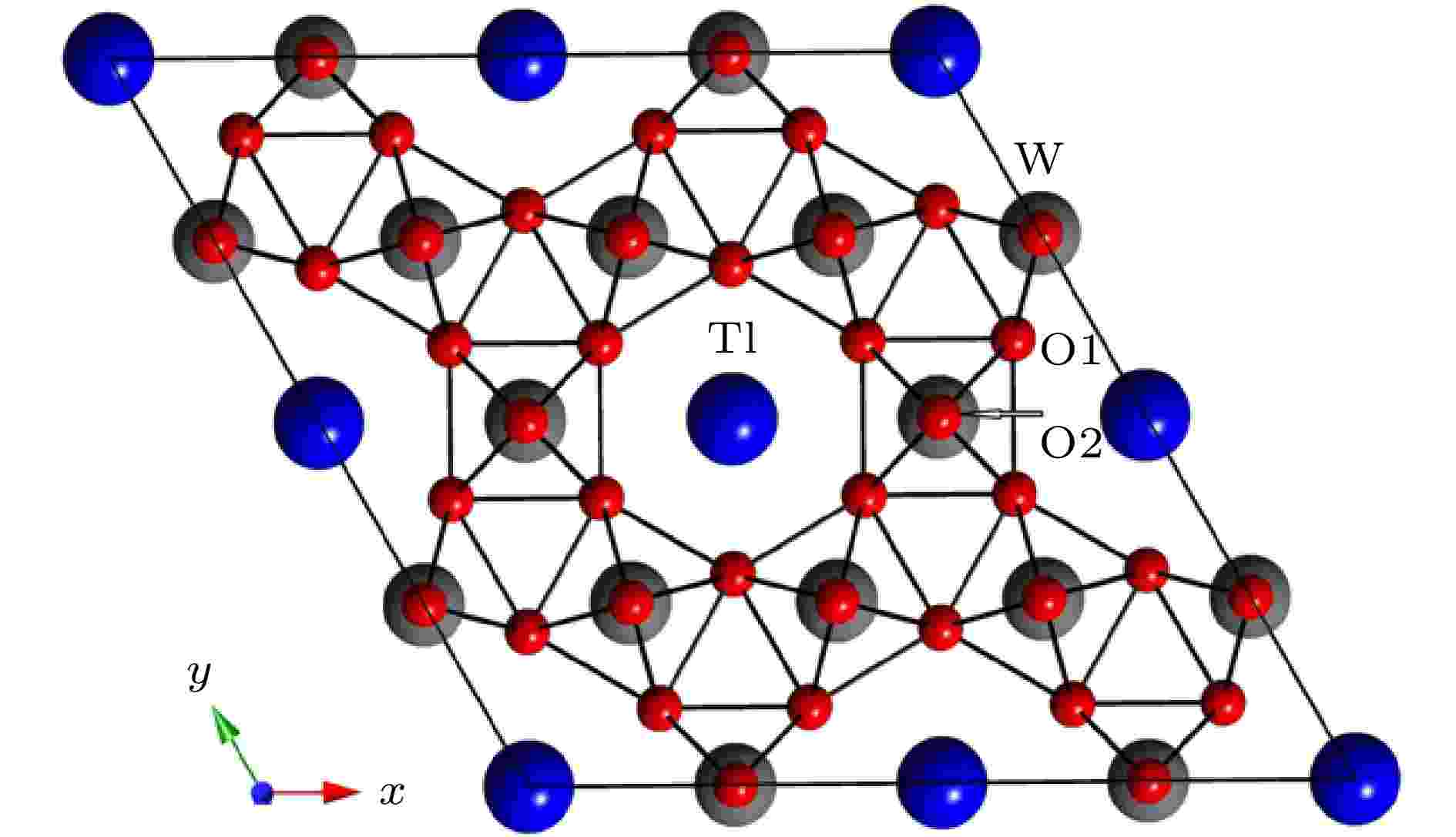
2020, 69 (4): 047102.
doi:10.7498/aps.69.20191577
Abstract +
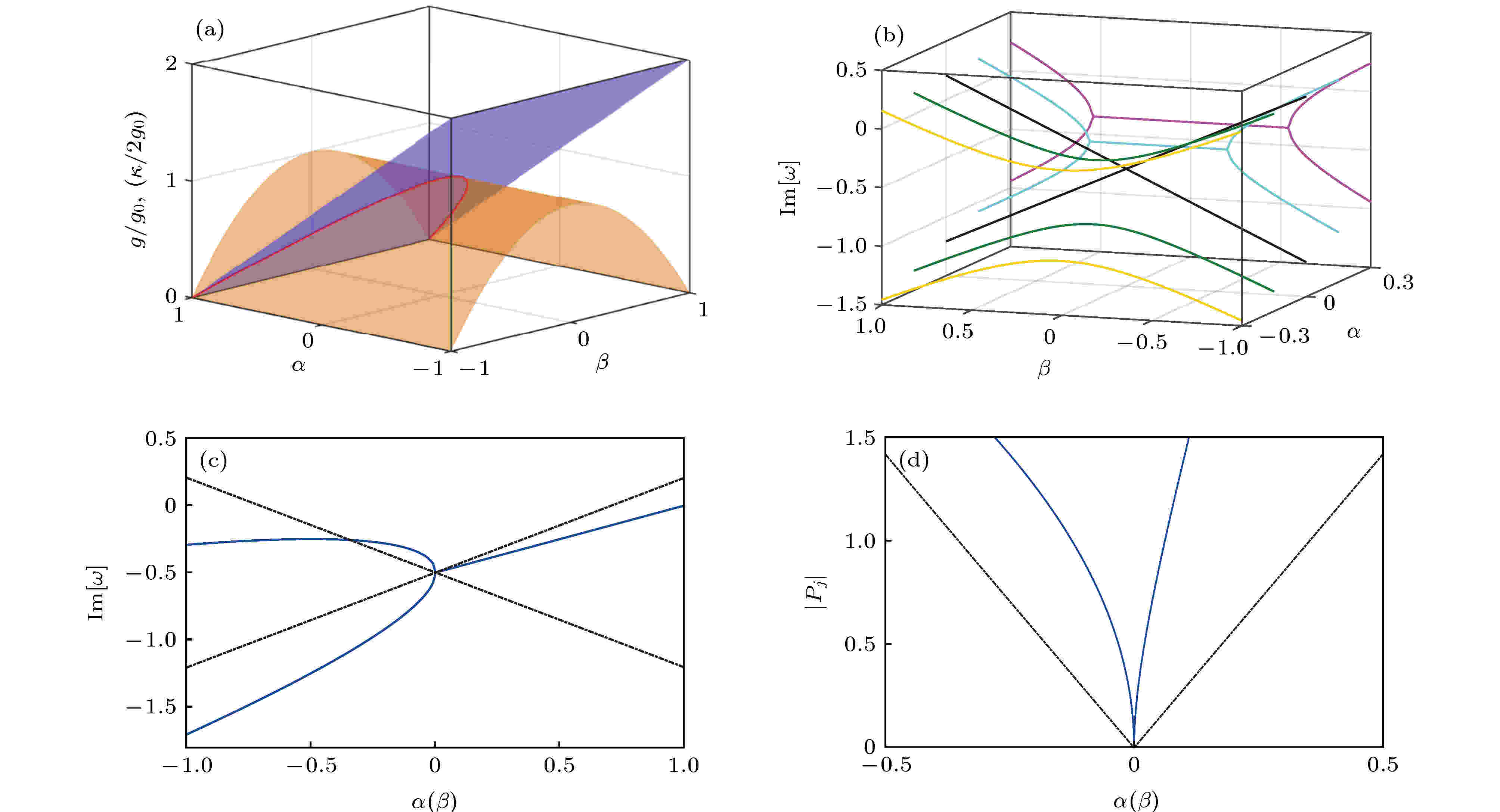
2020, 69 (4): 047103.
doi:10.7498/aps.69.20191632
Abstract +
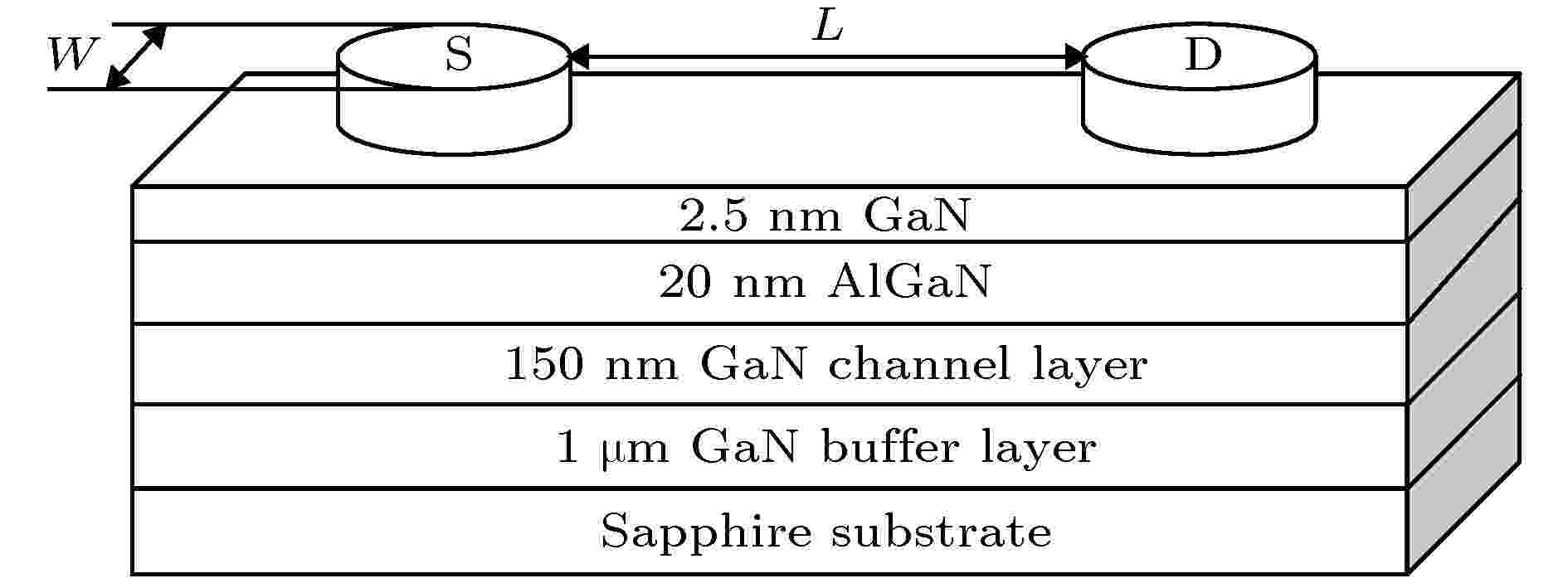
2020, 69 (4): 047201.
doi:10.7498/aps.69.20190640
Abstract +
Semiconductor temperature sensors have been widely used in medical, industrial, aviation and civil fields due to their advantages such as high sensitivity, small size, low power consumption and strong anti-interference ability. However, most Si-based temperature sensors are not suitable for the application in high-temperature environments. The new AlGaN/GaN heterojunction material not only has a wide band gap, but also has a high two-dimensional electron gas concentration and carrier mobility. Therefore, the device made with it not only has good electrical properties, but also can be applied in ultra-high environments. In this paper, a temperature sensor based on gateless AlGaN/GaN high electron mobility transistor structure was fabricated and its temperature-dependent electrical properties were characterized. The temperature dependence of current-voltage characteristics of the device were tested from 50 to 400 °C. The sensitivity of the device was studied as a function of the channel aspect ratio of the device. The stability of electrical properties was characterized after heating in air and nitrogen at 300—500 °C for 1 hour. The theoretical and experimental results show that as the aspect ratio of the device increases, the sensitivity of the device increases. At a fixed current of 0.01 A, the average sensitivity of the device voltage with temperature changes is 44.5 mV/°C. Meanwhile, the good high temperature retention stability is shown during stability experiments.
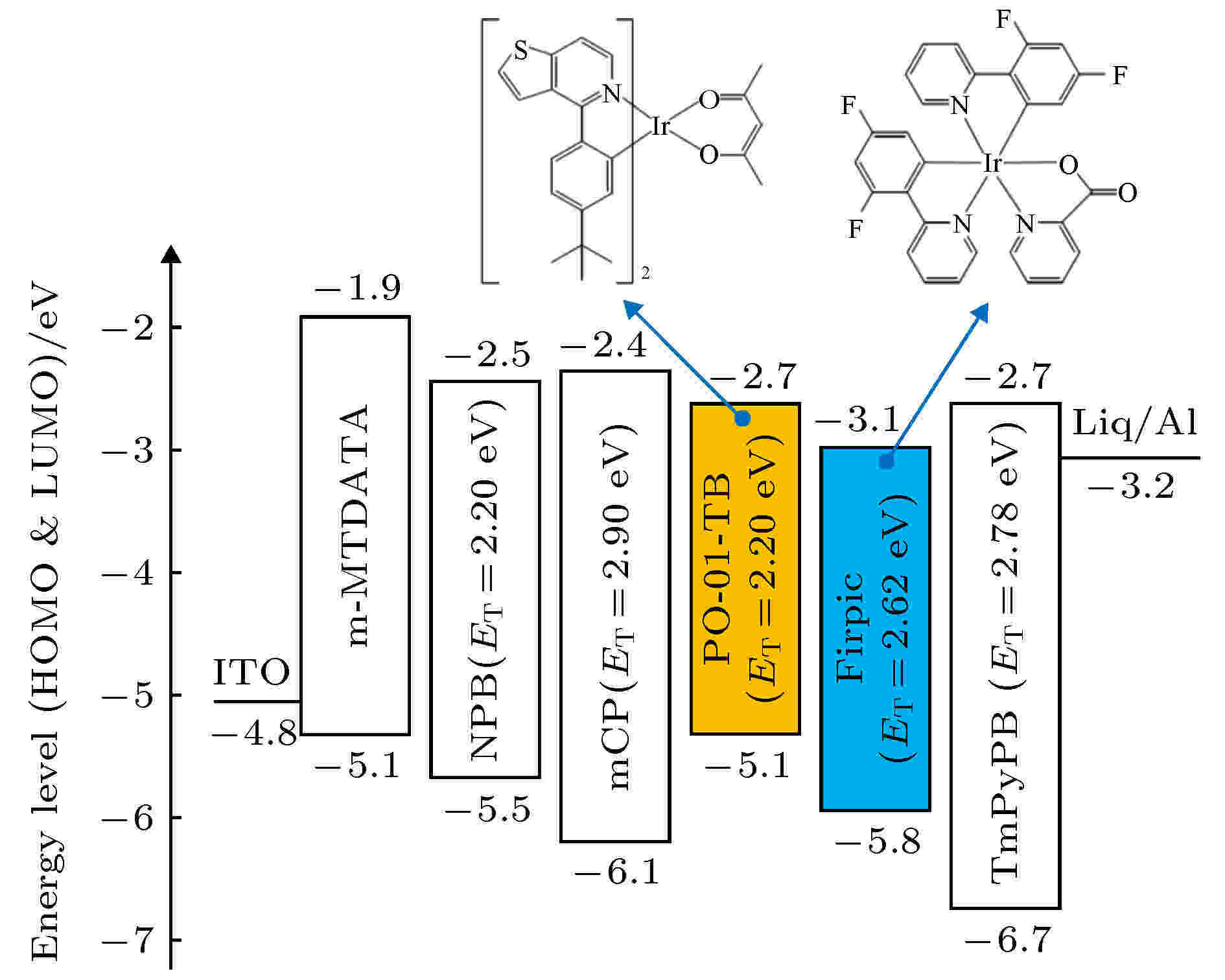
2020, 69 (4): 047202.
doi:10.7498/aps.69.20191594
Abstract +
White organic light-emitting diodes (WOLEDs) have drawn considerable attention for next-generation lighting and display applications owing to their remarkable advantages. Phosphorescent OLED technology is crucial to realize high-efficiency white OLEDs because phosphorescent emitters enable to achieve almost 100% internal quantum efficiency (IQE) by harvesting all the excitons of 75% of triplets and 25% of singlets. However, an efficiency roll-off at high-brightness and a shift in color under various operation biases remains challenges. With the goal towards commercial applications, it requires WOLEDs should simultaneously realize high efficiency at high-brightness region over 1000 cd/m2and good color stability over a wide electroluminescent range. In this paper, we first investigated the energy transfer process between the blue-emitting Bis (3,5-difluoro-2-(2-pyridyl)phenyl-(2-carboxypyridyl) iridium (III) (Firpic) and the orange emitting Iridium (III) bis(4-(4-tert-butylphenyl)thieno[3,2-c]pyridinato-N,C2')acetylacetonate (PO-01-TB), in addition to the behavior of the carrier trapping in the phosphorescent OLEDs with double emissive layers. Then we successfully fabricated phosphorescent WOLED with multiple emissive layers. The resulting phosphorescent WOLED achieves the maximum forward-viewing current efficiency (CE) of 34.6 cd/A and external quantum efficiency (EQE) of 13.5%, and the CE and the EQE remain 33.9 cd/A and 13.3% at 1000 cd/m2, respectively, indicating that the WOLED exhibits low efficiency roll-off. Furthermore, the WOLED shows very stable white emission with small Commission Internationale de L’Eclairage (CIE) coordinate varying range of (0.016, 0.011) from 1000 to 10000 cd/m2. The results provide a promising avenue to simultaneously achieve high efficiency, lower the efficiency roll-off at high brightness and color-stability for phosphorescent WOLEDs by carefully designing the device architecture to redistribute the charge carriers and excitons in the recombination zone.

COVER ARTICLE
2020, 69 (4): 047401.
doi:10.7498/aps.69.20191758
Abstract +
The magnetic penetration depth (λ) of a superconductor is an important parameter which connects the macroscopic electrodynamics with the microscopic mechanism of superconductivity. High-accuracy measurement ofλis of great significance for revealing the pairing mechanism of superconductivity and exploring the applications of superconductors. Among various methods used to measureλof superconducting films, the two-coil mutual inductance (MI) technique has been widely adopted due to its high precision and simplicity. In this paper, we start with introducing the principle of MI technique and pointing out that its accuracy is mainly limited by the uncertainties in the geometric parameters (e.g. the distance between two coils) and the leakage flux around the film edge. On this basis, we build a homemadetransmission-type MI device with a delicate design to achieve high-accuracy. Two coils are fixed by a single-crystal sapphire block machined with high precisions to minimize the uncertainty in geometry. As a result, the reproducibility in induced voltage measured with sample remounted is better than 4%. Besides, the flux leakage around the film edge is accurately determined by measuring a thick Nb film and Nb foils. The voltage induced by leakage flux is only around 1% of that measured in the normal state. Therefore, the absolute value ofλcan be accurately extracted after flux leakage subtraction and normalization. It is shown that the error of the measuredλis less than 10% for a typical superconducting film with a thickness of 100 nm and a penetration depth of 150 nm. Furthermore, the performance of our apparatus is tested on epitaxial NbN films with thickness of 6.5 nm. The results show that the low temperature variation of superfluid density is well described by the dirty s-wave BCS theory, and at temperatures close toTc, the superfluid density decrease drastically, owing to the Berezinski-Kosterlitz-Thouless transition transition. Moreover, the zero-temperature magnetic penetration depth and the superconducting energy gap extracted from the fitting parameters are both consistent with the reported values. Our device provides an ideal platform for carrying out detailed studies of the dependence ofλon temperature, chemical composition and epitaxial strain, etc. It could also be utilized to characterize other parameters of superconductor such as the critical current density, and when combined with the ionic liquid gating technique, our device offers an efficient route for revealing the microscopic mechanism of superconductivity.
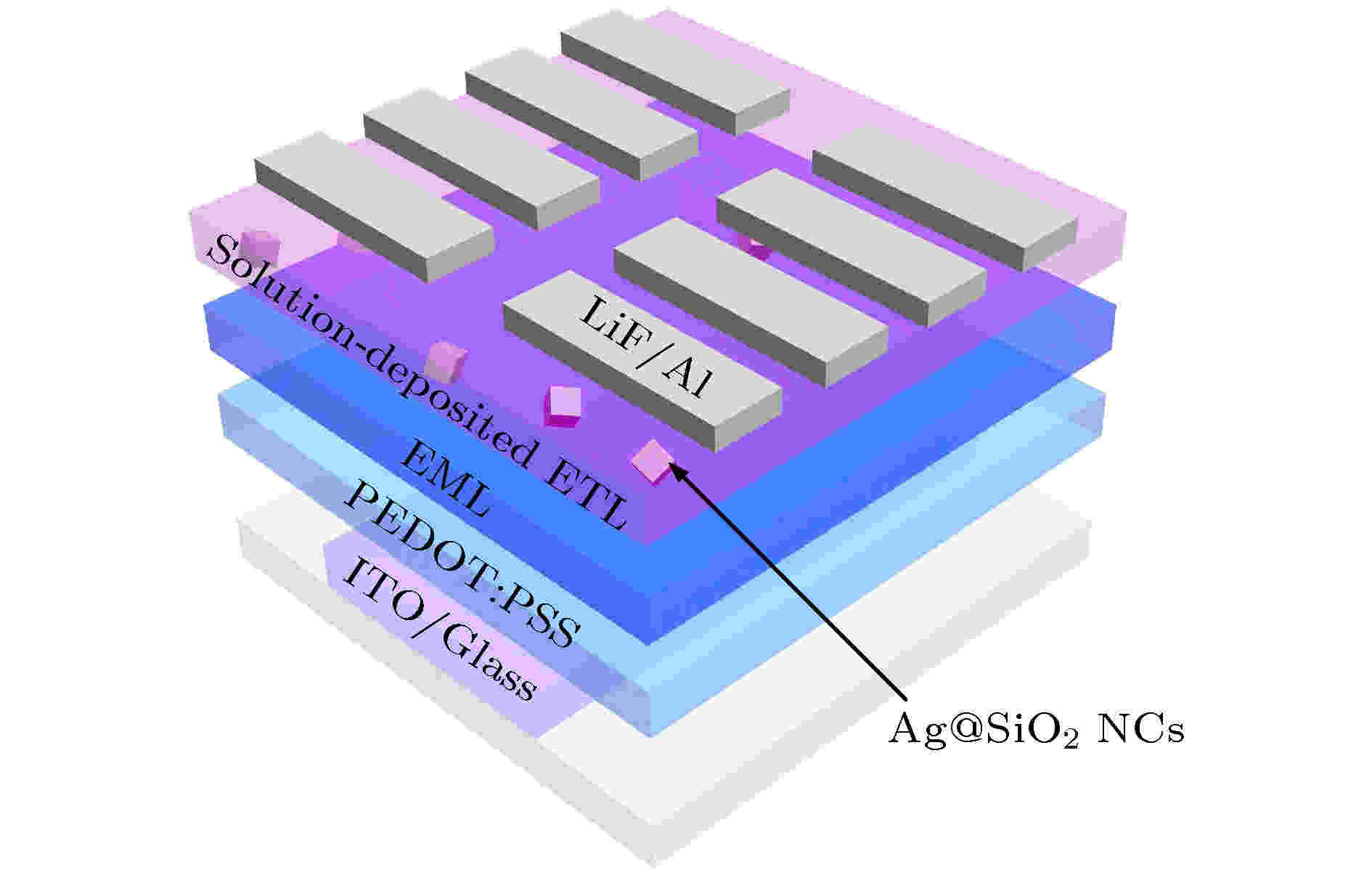
2020, 69 (4): 047801.
doi:10.7498/aps.69.20191526
Abstract +
Localized surface plasmon resonance (LSPR) effect of metal nanoparticles (MNs) has been widely applied in organic light-emitting diodes (OLEDs) to improve the radiation of excitons. The LSPR wavelength and intensity of MNs and the coupling between MNs and excitons greatly affect the LSPR effect on exciton radiation. In this work, silica coated silver nanocubes (Ag@SiO2NCs) were doped in the electron transport layer (ETL) of a solution-processed multilayered white OLED (WOLED). Due to the sharp edges and corners, Ag NCs have strong LSPR effect and can effectively enhance the radiation of nearby excitons. With an appropriate concentration of Ag@SiO2NCs, the WOLED achieved two fold improvement in the current efficiency comparing with the control device without Ag@SiO2NCs incorporated. The working mechanism of the Ag@SiO2NCs based WOLED was investigated in detail. For the solution-processed OLED, excitons usually form and recombine near the interface of emission layer and electron transport layer (EML/ETL) because the commonly used host material (such as polyvinylcarbazole, PVK) has the unipolar hole transport property. So the Ag@SiO2NCs in ETL greatly enhanced the radiation of the excitons located near the EML/ETL interface, which mostly contributed to the performance enhancement of the Ag@SiO2NCs based WOLED. Study on a group of devices with Ag@SiO2NCs doped in different locations indicated that Ag@SiO2NCs in ETL showed more effective LSPR effect than those in hole injection layer. Electroluminescence and photoluminescence spectra of the WOLEDs declared that the Ag@SiO2NCs simultaneously improved the radiation intensities of the blue and yellow excitons and helped the WOLED maintain the good chromaticity stability, which was mainly attributed to the wide LSPR wavelength range (450–650 nm) of the Ag@SiO2NCs. The SiO2coating layer of the Ag@SiO2NCs played the important role in the LSPR enhanced emission. On the one hand, it formed an appropriated distance between the Ag NCs and the extions, helping to generate the strong coupling between them. On the other hand, it suppressed the effect of Ag NCs on charge trapping, keeping the stability of the carrier transport in the device. Our research demonstrate MNs can effectively improve the performance of OLEDs by carefully designing the device structure.
INTERDISCIPLINARY PHYSICS AND RELATED AREAS OF SCIENCE AND TECHNOLOGY
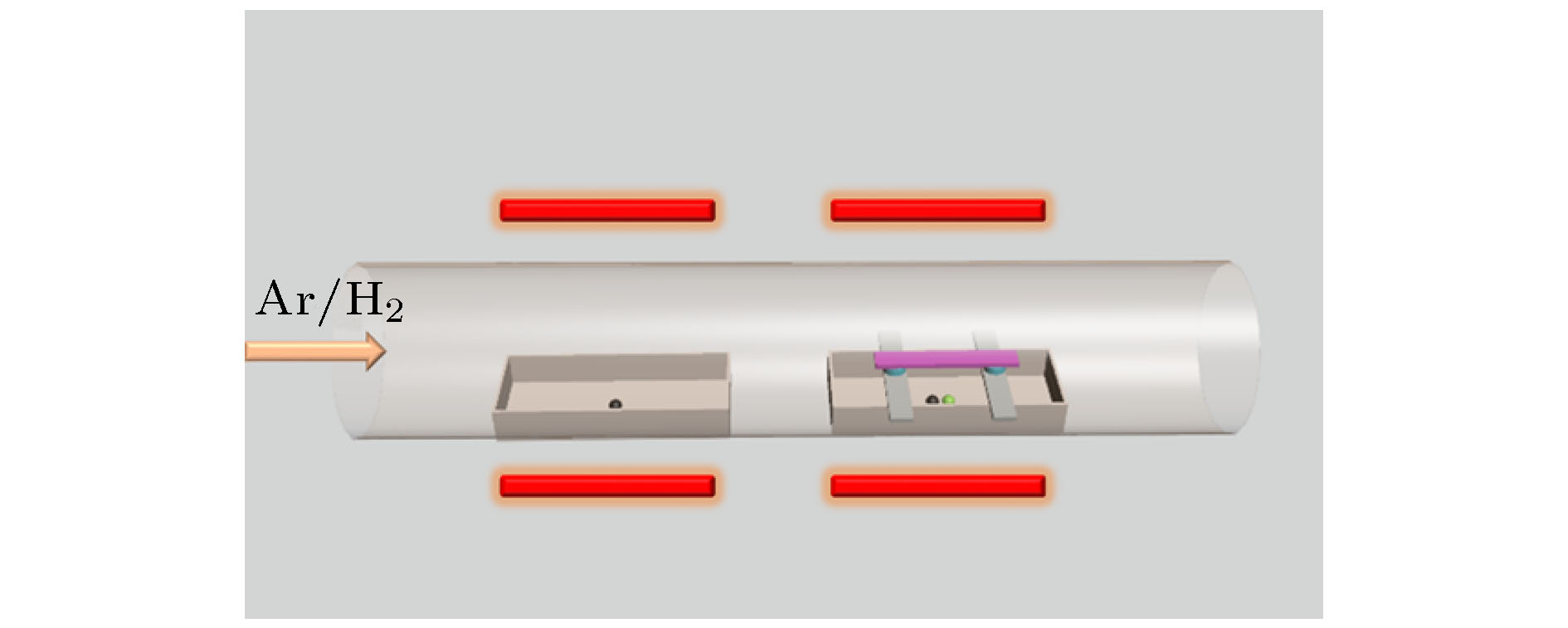
2020, 69 (4): 048101.
doi:10.7498/aps.69.20191302
Abstract +
In this paper, Co3O4、MoO3and Se powders were used as precursors in in-situ co-growth chemical vapor deposition method. Cobalt-doped MoSe2nanosheets were grown on SiO2substrate at 710 ℃. The influence of hydrogen content on its growth and regulation mechanism was discussed. Surface morphology analysis showed that the introduction of hydrogen promoted the formation of oxy-selenium metal compounds required for nucleation and the CoMoSe compound molecules required for lateral growth. AFM(atomic force microscope) results show that hydrogen is beneficial to the growth of single-layer two-dimensional cobalt-doped MoSe2. With the increase of the amount of Co3O4precursor, the Raman and PL(photoluminescence) spectra of the sample showed red shift and blue shift, respectively, and the bandgap was modulated from 1.52 eV to 1.57 eV. The XPS(X-ray photoelectron spectroscopy) results analysis showed that the elemental composition ratio of Co was 4.4%. The magneto and electric properties of the samples were analyzed by SQUID-VSM(superconducting quantum interference device) and semiconductor parameter analyzer for electrical testing. The results show that MoSe2changes from diamagnetic to soft magnetic after Co incorporation; the threshold voltage of back gate FETs is shifted by 5 V from pure MoSe2, and the off-state current is lower. This research provides a basis for the research and application development of ultra-thin two-dimensional materials.
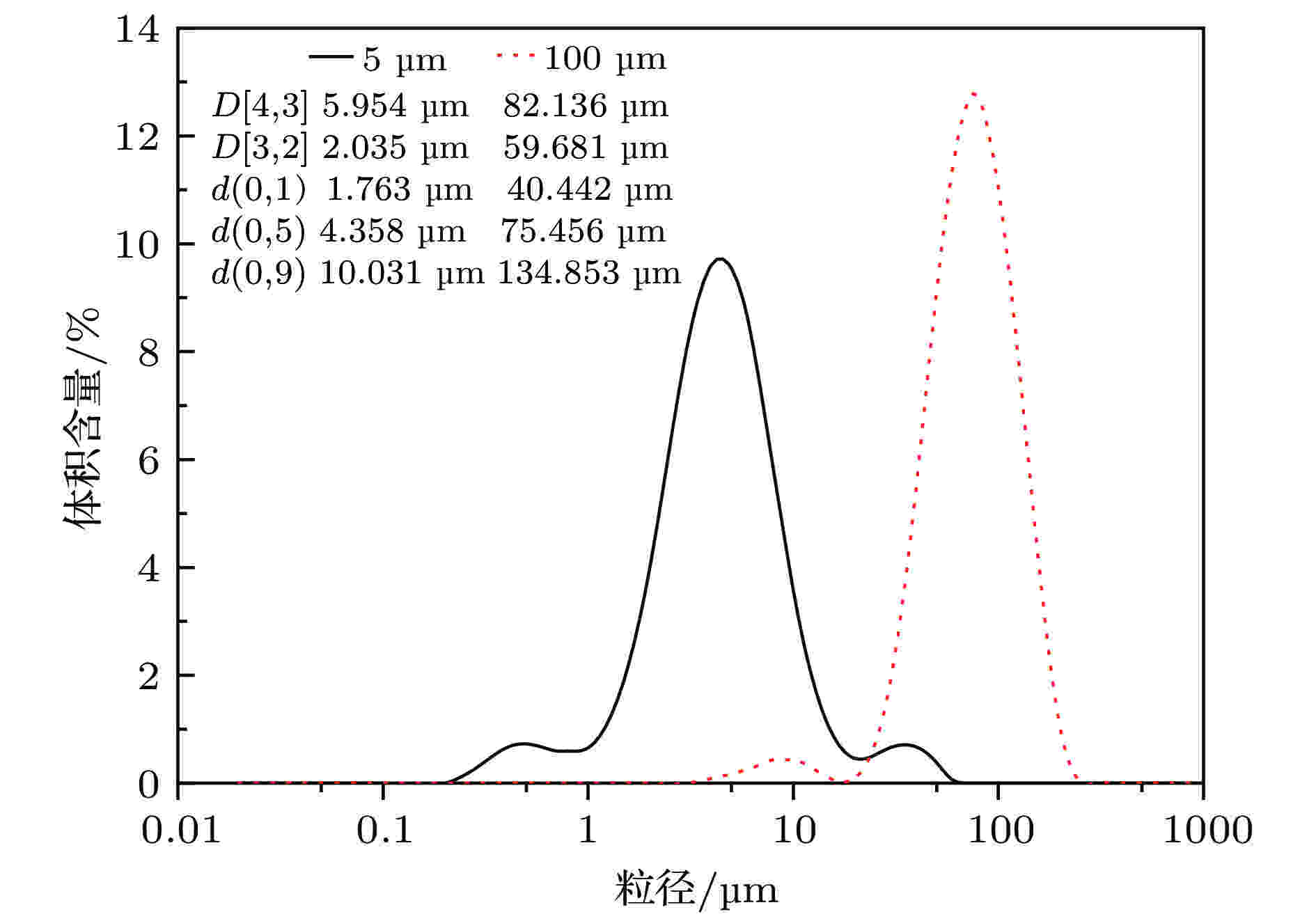
2020, 69 (4): 048102.
doi:10.7498/aps.69.20191273
Abstract +
Powder engine is one kind of new concept engines with multiple ignition capability and thrust modulation function. Powder filling is an important process of the powder engine tests. The powder pneumatic filling experiments were carried out to investigate the effects of the filling position of the powder collection box and the mass flow rate of fluidization gas on the stability and performance of powder pneumatic filling. It’s found that large mass flow rate of fluidization gas contributes to stability of powder pneumatic filling, but its volume efficiency of powder filling is the lowest, only 68.1%, but it’s 93.9% when the mass flow rate of fluidization gas is small. Compared with the vertical inlet of end cap, tangential inlet on the cylinder wall makes the powder uniformity better. In the pneumatic filling mode, the powder bulk density in the collection box is greater than the bulk density in the powder tank. In addition, the mass of powder calculated by position displacement is always larger than the mass of powder measured by the electronic balance. It indicates powder bulk density in tank is constantly changing during the powder pneumatic filling experiments. The actual powder bulk density in the powder tank is calculated by a model established in this paper, it’s found that when the mass flow rate of fluidization gas is low, the bulk density of the powder in the tank is increased first and then decreased, and the final bulk density is less than the initial value. While the mass flow rate of fluidization gas is high, powder bulk density in the tank is first increased, then decreased, then increased and then decreased, and the final bulk density is greater than the initial value. The compression mechanism of powder bulk density in the tank is similar to the motion law of the damper spring vibrator when it is forced to vibrate. It can be described by the damped second-order system response function. When the mass flow rate of fluidization gas is small, the damping coefficient of the system is smaller. While the mass flow rate of fluidization gas is large, the damping coefficient is larger and is variable.
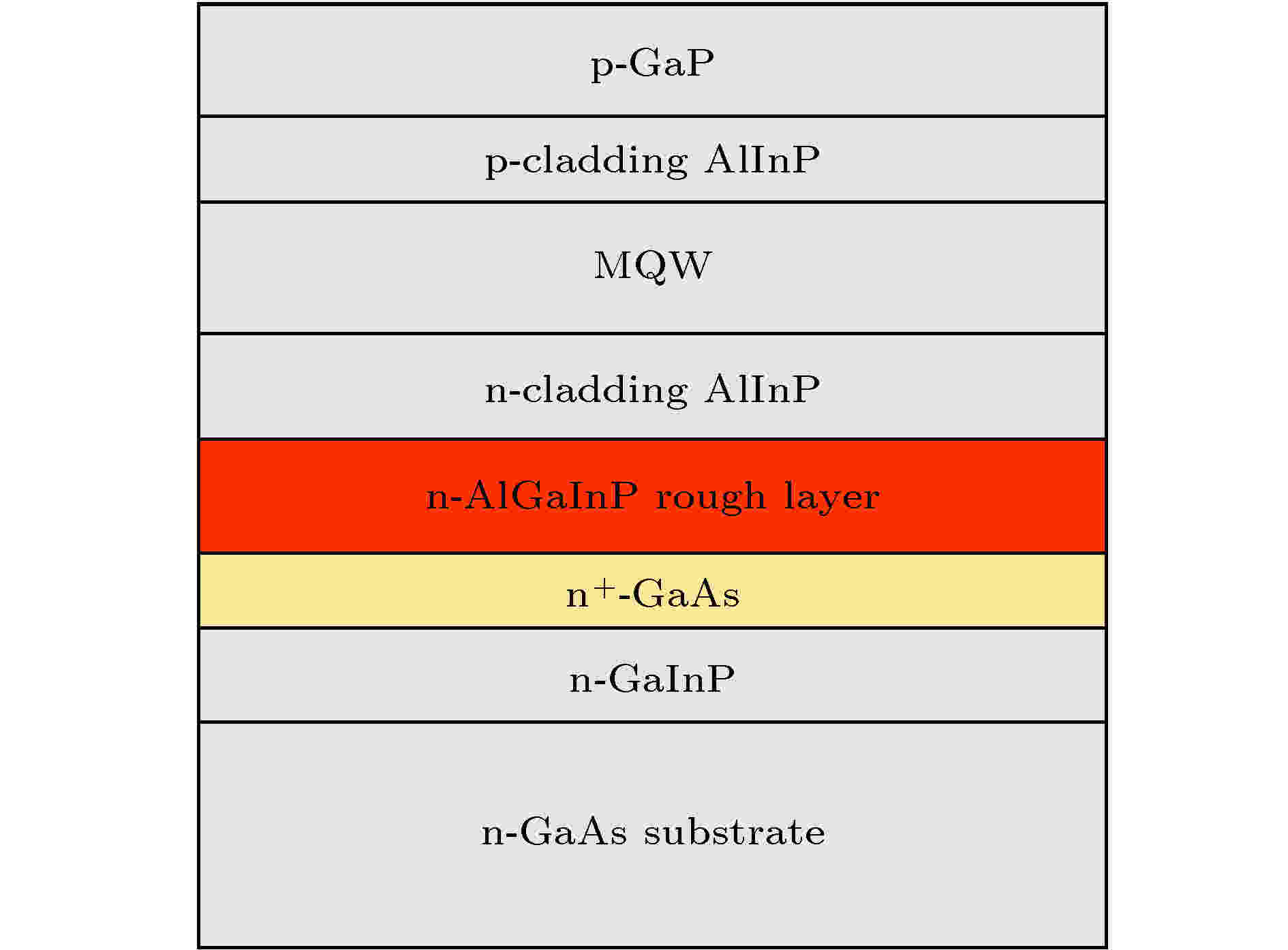
EDITOR'S SUGGESTION
2020, 69 (4): 048103.
doi:10.7498/aps.69.20191720
Abstract +
In this paper, Ni/Au/Ge/Ni/Au laminated metals were deposited on the n-(Al0.27Ga0.73)0.5In0.5P by electron beam evaporation, the ohmic contact with low contact resistance was successfully prepared by optimized annealing process. The specific contact resistance reached 1.4 × 10–4Ω·cm2when annealed at 445 ℃ for 600 s. The result of the secondary ion mass spectrometer shows that the solid-state reaction takes place at the interface between the laminated metal Ni/Au/Ge/Ni/Au and n-AlGaInP, then the germanium atoms and indium atoms diffuse outwards due to thermal decomposition and leave vacancies in the lattice. In this paper, the reason for the formation of ohmic contact is attributed to the fact that the germanium vacancy and indium vacancy are occupied by gallium atoms as donors to increasing the N-type doping concentration. The optimized annealing process can improve the ohmic contact performance of n-(Al0.27Ga0.73)0.5In0.5P with low doping concentration, but the specific contact resistivity has no obvious relationship with the annealing process when the of doping concentration of n-(Al0.27Ga0.73)0.5In0.5P increased. The Schottky barrier is high at low doping concentration of n-(Al0.27Ga0.73)0.5In0.5P. So inter diffusion in the annealing process could significantly increase the doping concentration of n-(Al0.27Ga0.73)0.5In0.5P and reduce the Schottky barrier height. Nevertheless, the Schottky barrier of the sample with high doping concentration is low enough what is not sensitive with inter diffusion. It provides a new method for the preparation of N-electrode of AlGaInP thin film light-emitting-diodes chip, as so as avoid the problem of n+-GaAs absorption in the conventional N-electrode preparation method and the problem of electrode dropping. However, there are still some shortcomings in this paper. The disadvantage is that the high doping concentration of n-AlGaInP will affect the crystal quality, which will reduce the luminous efficiency of LED. Therefore, in order to prepare ohmic contact with excellent properties on n-AlGaInP with lower doping concentration, optimizing the electrode design and the surface treatment of semiconductor materials are the keys to follow-up research.











